
Rutina Mochila
pt
(En
portugués)
Las rutinas son todas aquellas actividades o acciones que llevamos a cabo en nuestro día a día de manera regular y sistemática, es decir, se trata de hábitos o costumbres que adquirimos tras repetirlos muchas veces y que, posteriormente, realizamos de manera automática y sin que impliquen un sobre esfuerzo de razonamiento. Para muchas personas, niños/as y adultos/as, estas actividades diarias suponen un problema añadido a su día a día, por lo que es necesario trabajarlas desde la anticipación y la práctica diaria, marcando y reforzando cada uno de los pasos o secuencias de las que se componen. Comprender y automatizar estas tareas, se traduce en la comprensión y estructuración de sus días y del mundo que les rodea y en el cual deben interactuar y participar. Para esta comprensión y posterior automatización, se hace necesario un proceso importante de aprendizaje y apoyo, de ahí que hayamos creado, gracias a Eneso Verbo, una serie de tableros basados en rutinas diarias, con el objetivo de apoyar este proceso de anticipación, aprendizaje y automatización de las distintas rutinas diarias. Con este recurso trabajaremos las distintas secuencias necesarias para aprender la rutina de preparar la mochila para el cole.
Compartido por: Adapt4you

Hago pipí
es
Las rutinas son todas aquellas actividades o acciones que llevamos a cabo en nuestro día a día de manera regular y sistemática, es decir, se trata de hábitos o costumbres que adquirimos tras repetirlos muchas veces y que, posteriormente, realizamos de manera automática y sin que impliquen un sobre esfuerzo de razonamiento. Para muchas personas, niños/as y adultos/as, estas actividades diarias suponen un problema añadido a su día a día, por lo que es necesario trabajarlas desde la anticipación y la práctica diaria, marcando y reforzando cada uno de los pasos o secuencias de las que se componen. Comprender y automatizar estas tareas, se traduce en la comprensión y estructuración de sus días y del mundo que les rodea y en el cual deben interactuar y participar. Para esta comprensión y posterior automatización, se hace necesario un proceso importante de aprendizaje y apoyo, de ahí que hayamos creado, gracias a Eneso Verbo, una serie de tableros basados en rutinas diarias, con el objetivo de apoyar este proceso de anticipación, aprendizaje y automatización de las distintas rutinas diarias. Con este recurso trabajaremos las distintas secuencias necesarias para aprender la rutina de hacer pipí.
Compartido por: Eneso

Preparo mi mochila para el cole
es
Las rutinas son todas aquellas actividades o acciones que llevamos a cabo en nuestro día a día de manera regular y sistemática, es decir, se trata de hábitos o costumbres que adquirimos tras repetirlos muchas veces y que, posteriormente, realizamos de manera automática y sin que impliquen un sobre esfuerzo de razonamiento. Para muchas personas, niños/as y adultos/as, estas actividades diarias suponen un problema añadido a su día a día, por lo que es necesario trabajarlas desde la anticipación y la práctica diaria, marcando y reforzando cada uno de los pasos o secuencias de las que se componen. Comprender y automatizar estas tareas, se traduce en la comprensión y estructuración de sus días y del mundo que les rodea y en el cual deben interactuar y participar. Para esta comprensión y posterior automatización, se hace necesario un proceso importante de aprendizaje y apoyo, de ahí que hayamos creado, gracias a Eneso Verbo, una serie de tableros basados en rutinas diarias, con el objetivo de apoyar este proceso de anticipación, aprendizaje y automatización de las distintas rutinas diarias. Con este recurso trabajaremos las distintas secuencias necesarias para aprender la rutina de preparar la mochila para el cole.
Compartido por: Eneso

Ponemos la mesa
es
Las rutinas son todas aquellas actividades o acciones que llevamos a cabo en nuestro día a día de manera regular y sistemática, es decir, se trata de hábitos o costumbres que adquirimos tras repetirlos muchas veces y que, posteriormente, realizamos de manera automática y sin que impliquen un sobre esfuerzo de razonamiento. Para muchas personas, niños/as y adultos/as, estas actividades diarias suponen un problema añadido a su día a día, por lo que es necesario trabajarlas desde la anticipación y la práctica diaria, marcando y reforzando cada uno de los pasos o secuencias de las que se componen. Comprender y automatizar estas tareas, se traduce en la comprensión y estructuración de sus días y del mundo que les rodea y en el cual deben interactuar y participar. Para esta comprensión y posterior automatización, se hace necesario un proceso importante de aprendizaje y apoyo, de ahí que hayamos creado, gracias a Eneso Verbo, una serie de tableros basados en rutinas diarias, con el objetivo de apoyar este proceso de anticipación, aprendizaje y automatización de las distintas rutinas diarias. Con este recurso trabajaremos las distintas secuencias necesarias para aprender la rutina de poner la mesa.
Compartido por: Eneso

Me lavo las manos
es
Las rutinas son todas aquellas actividades o acciones que llevamos a cabo en nuestro día a día de manera regular y sistemática, es decir, se trata de hábitos o costumbres que adquirimos tras repetirlos muchas veces y que, posteriormente, realizamos de manera automática y sin que impliquen un sobre esfuerzo de razonamiento. Para muchas personas, niños/as y adultos/as, estas actividades diarias suponen un problema añadido a su día a día, por lo que es necesario trabajarlas desde la anticipación y la práctica diaria, marcando y reforzando cada uno de los pasos o secuencias de las que se componen. Comprender y automatizar estas tareas, se traduce en la comprensión y estructuración de sus días y del mundo que les rodea y en el cual deben interactuar y participar. Para esta comprensión y posterior automatización, se hace necesario un proceso importante de aprendizaje y apoyo, de ahí que hayamos creado, gracias a Eneso Verbo, una serie de tableros basados en rutinas diarias, con el objetivo de apoyar este proceso de anticipación, aprendizaje y automatización de las distintas rutinas diarias. Con este recurso trabajaremos las distintas secuencias necesarias para aprender la rutina de lavarse las manos.
Compartido por: Eneso

Rutina facial
es
Las rutinas son todas aquellas actividades o acciones que llevamos a cabo en nuestro día a día de manera regular y sistemática, es decir, se trata de hábitos o costumbres que adquirimos tras repetirlos muchas veces y que, posteriormente, realizamos de manera automática y sin que impliquen un sobre esfuerzo de razonamiento. Para muchas personas, niños/as y adultos/as, estas actividades diarias suponen un problema añadido a su día a día, por lo que es necesario trabajarlas desde la anticipación y la práctica diaria, marcando y reforzando cada uno de los pasos o secuencias de las que se componen. Comprender y automatizar estas tareas, se traduce en la comprensión y estructuración de sus días y del mundo que les rodea y en el cual deben interactuar y participar. Para esta comprensión y posterior automatización, se hace necesario un proceso importante de aprendizaje y apoyo, de ahí que hayamos creado, gracias a Eneso Verbo, una serie de tableros basados en rutinas diarias, con el objetivo de apoyar este proceso de anticipación, aprendizaje y automatización de las distintas rutinas diarias. Con este recurso trabajaremos las distintas secuencias necesarias para aprender la rutina de cuidarse la cara y hacer un correcto skincare.
Compartido por: Eneso

Hora de dormir
es
Las rutinas son todas aquellas actividades o acciones que llevamos a cabo en nuestro día a día de manera regular y sistemática, es decir, se trata de hábitos o costumbres que adquirimos tras repetirlos muchas veces y que, posteriormente, realizamos de manera automática y sin que impliquen un sobre esfuerzo de razonamiento. Para muchas personas, niños/as y adultos/as, estas actividades diarias suponen un problema añadido a su día a día, por lo que es necesario trabajarlas desde la anticipación y la práctica diaria, marcando y reforzando cada uno de los pasos o secuencias de las que se componen. Comprender y automatizar estas tareas, se traduce en la comprensión y estructuración de sus días y del mundo que les rodea y en el cual deben interactuar y participar. Para esta comprensión y posterior automatización, se hace necesario un proceso importante de aprendizaje y apoyo, de ahí que hayamos creado, gracias a Eneso Verbo, una serie de tableros basados en rutinas diarias, con el objetivo de apoyar este proceso de anticipación, aprendizaje y automatización de las distintas rutinas diarias. Con este recurso trabajaremos las distintas secuencias necesarias para aprender la rutina de irse a dormir.
Compartido por: Eneso

Me lavo los dientes
es
Las rutinas son todas aquellas actividades o acciones que llevamos a cabo en nuestro día a día de manera regular y sistemática, es decir, se trata de hábitos o costumbres que adquirimos tras repetirlos muchas veces y que, posteriormente, realizamos de manera automática y sin que impliquen un sobre esfuerzo de razonamiento. Para muchas personas, niños/as y adultos/as, estas actividades diarias suponen un problema añadido a su día a día, por lo que es necesario trabajarlas desde la anticipación y la práctica diaria, marcando y reforzando cada uno de los pasos o secuencias de las que se componen. Comprender y automatizar estas tareas, se traduce en la comprensión y estructuración de sus días y del mundo que les rodea y en el cual deben interactuar y participar. Para esta comprensión y posterior automatización, se hace necesario un proceso importante de aprendizaje y apoyo, de ahí que hayamos creado, gracias a Eneso Verbo, una serie de tableros basados en rutinas diarias, con el objetivo de apoyar este proceso de anticipación, aprendizaje y automatización de las distintas rutinas diarias. Con este recurso trabajaremos las distintas secuencias necesarias para aprender la rutina de lavarse los dientes.
Compartido por: Eneso

En el comedor
es
Las rutinas son todas aquellas actividades o acciones que llevamos a cabo en nuestro día a día de manera regular y sistemática, es decir, se trata de hábitos o costumbres que adquirimos tras repetirlos muchas veces y que, posteriormente, realizamos de manera automática y sin que impliquen un sobre esfuerzo de razonamiento. Para muchas personas, niños/as y adultos/as, estas actividades diarias suponen un problema añadido a su día a día, por lo que es necesario trabajarlas desde la anticipación y la práctica diaria, marcando y reforzando cada uno de los pasos o secuencias de las que se componen. Comprender y automatizar estas tareas, se traduce en la comprensión y estructuración de sus días y del mundo que les rodea y en el cual deben interactuar y participar. Para esta comprensión y posterior automatización, se hace necesario un proceso importante de aprendizaje y apoyo, de ahí que hayamos creado, gracias a Eneso Verbo, una serie de tableros basados en rutinas diarias, con el objetivo de apoyar este proceso de anticipación, aprendizaje y automatización de las distintas rutinas diarias. Con este recurso trabajaremos las distintas secuencias necesarias para aprender la rutina de comer en el comedor.
Compartido por: Eneso

Me lavo la cara
es
Las rutinas son todas aquellas actividades o acciones que llevamos a cabo en nuestro día a día de manera regular y sistemática, es decir, se trata de hábitos o costumbres que adquirimos tras repetirlos muchas veces y que, posteriormente, realizamos de manera automática y sin que impliquen un sobre esfuerzo de razonamiento. Para muchas personas, niños/as y adultos/as, estas actividades diarias suponen un problema añadido a su día a día, por lo que es necesario trabajarlas desde la anticipación y la práctica diaria, marcando y reforzando cada uno de los pasos o secuencias de las que se componen. Comprender y automatizar estas tareas, se traduce en la comprensión y estructuración de sus días y del mundo que les rodea y en el cual deben interactuar y participar. Para esta comprensión y posterior automatización, se hace necesario un proceso importante de aprendizaje y apoyo, de ahí que hayamos creado, gracias a Eneso Verbo, una serie de tableros basados en rutinas diarias, con el objetivo de apoyar este proceso de anticipación, aprendizaje y automatización de las distintas rutinas diarias. Con este recurso trabajaremos las distintas secuencias necesarias para aprender la rutina de lavarse la cara.
Compartido por: Eneso

Hago caca
es
Las rutinas son todas aquellas actividades o acciones que llevamos a cabo en nuestro día a día de manera regular y sistemática, es decir, se trata de hábitos o costumbres que adquirimos tras repetirlos muchas veces y que, posteriormente, realizamos de manera automática y sin que impliquen un sobre esfuerzo de razonamiento. Para muchas personas, niños/as y adultos/as, estas actividades diarias suponen un problema añadido a su día a día, por lo que es necesario trabajarlas desde la anticipación y la práctica diaria, marcando y reforzando cada uno de los pasos o secuencias de las que se componen. Comprender y automatizar estas tareas, se traduce en la comprensión y estructuración de sus días y del mundo que les rodea y en el cual deben interactuar y participar. Para esta comprensión y posterior automatización, se hace necesario un proceso importante de aprendizaje y apoyo, de ahí que hayamos creado, gracias a Eneso Verbo, una serie de tableros basados en rutinas diarias, con el objetivo de apoyar este proceso de anticipación, aprendizaje y automatización de las distintas rutinas diarias. Con este recurso trabajaremos las distintas secuencias necesarias para aprender la rutina de hacer caca.
Compartido por: Eneso

El cuerpo humano
es
Este tablero es una digitalización y adaptación de los contenidos educativos referentes al Cuerpo Humano.
Compartido por: Eneso

Comunicador núcleo Verbo con apps
es
Un comunicador completo basado en el paradigma de vocabulario núcleo, con capacidad de conjugación automática, separación en categorías gramaticales y varias secciones semánticas.
Esta nueva versión del comunicador núcleo incluye una página con todas las celdas de la integración de Eneso Verbo con Join-In.
Compartido por: Eneso

Teclado estilo oscuro con apps
es
Un teclado virtual con predicción de escritura y capacidad para almacenar notas. Estilo oscuro.
Esta nueva versión del teclado estilo oscuro incluye una página con todas las celdas de la integración de Eneso Verbo con Join-In.
Compartido por: Eneso
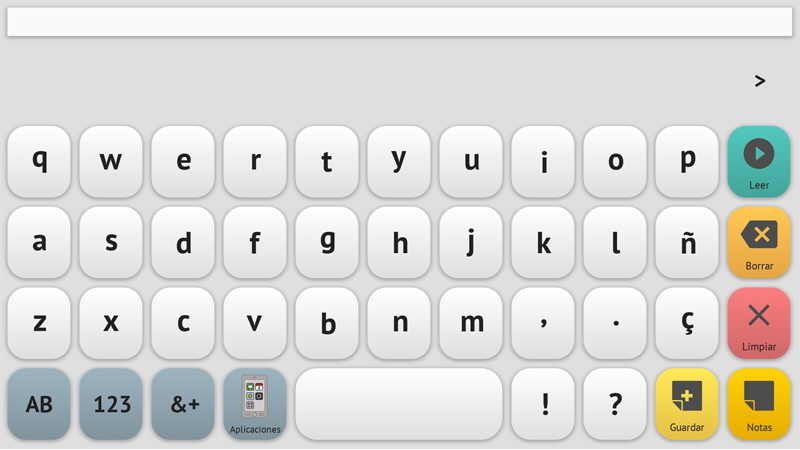
Teclado estilo claro con apps
es
Un teclado virtual con predicción de escritura y capacidad para almacenar notas. Estilo claro.
Esta nueva versión del teclado en estilo claro incluye una página con todas las celdas de la integración de Eneso Verbo con Join-In.
Compartido por: Eneso

Comunicador texto con apps
es
Un comunicador con representación del lenguaje puramente textual, con capacidad de conjugación automática en persona, número y tiempo verbal, predicción de escritura y notas. Incluye varias categorías semánticas.
Esta nueva versión del comunicador texto incluye una página con todas las celdas de la integración de Eneso Verbo con Join-In.
Compartido por: Eneso

Reproductor
es
Página complementaria para añadir a los tableros y tener siempre un reproductor en tu tablero de comunicación.
Podrás descargarla e importarla a tus tableros (tableros de comunicación, actividades, juegos, etc.) con los que ya trabajes o te comuniques.
Compartido por: Eneso

Rutina Playa
pt
(En
portugués)
Las rutinas son todas aquellas actividades o acciones que llevamos a cabo en nuestro día a día de manera regular y sistemática, es decir, se trata de hábitos o costumbres que adquirimos tras repetirlos muchas veces y que, posteriormente, realizamos de manera automática y sin que impliquen un sobre esfuerzo de razonamiento. Para muchas personas, niños/as y adultos/as, estas actividades diarias suponen un problema añadido a su día a día, por lo que es necesario trabajarlas desde la anticipación y la práctica diaria, marcando y reforzando cada uno de los pasos o secuencias de las que se componen. Comprender y automatizar estas tareas, se traduce en la comprensión y estructuración de sus días y del mundo que les rodea y en el cual deben interactuar y participar. Para esta comprensión y posterior automatización, se hace necesario un proceso importante de aprendizaje y apoyo, de ahí que hayamos creado, gracias a Eneso Verbo, una serie de tableros basados en rutinas diarias, con el objetivo de apoyar este proceso de anticipación, aprendizaje y automatización de las distintas rutinas diarias. Con este recurso trabajaremos las distintas secuencias necesarias para aprender la rutina de ir a la playa.
Compartido por: Adapt4you

Rutina Piscina
pt
(En
portugués)
Para muchas personas, niños/as y adultos/as, estas actividades diarias suponen un problema añadido a su día a día, por lo que es necesario trabajarlas desde la anticipación y la práctica diaria, marcando y reforzando cada uno de los pasos o secuencias de las que se componen. Comprender y automatizar estas tareas, se traduce en la comprensión y estructuración de sus días y del mundo que les rodea y en el cual deben interactuar y participar. Para esta comprensión y posterior automatización, se hace necesario un proceso importante de aprendizaje y apoyo, de ahí que hayamos creado, gracias a Eneso Verbo, una serie de tableros basados en rutinas diarias, con el objetivo de apoyar este proceso de anticipación, aprendizaje y automatización de las distintas rutinas diarias. Con este recurso trabajaremos las distintas secuencias necesarias para aprender la rutina de ir a la piscina.
Compartido por: Adapt4you

Veo veo
es
Todos conocemos este famoso juego del Veo Veo al que hemos recurrido en multitud de ocasiones para hacer más ameno un viaje o para entretenernos en situaciones concretas. Con este nuevo recurso de Verbo, podremos jugar a este juego tan divertido y versátil, además de utilizarlo como actividad para apoyar determinados procesos de aprendizaje.
Este tipo de juegos o de actividades, estimulan la creatividad de los/as niños/as, ya que tienen que buscar y encontrar objetos, por lo que favorece el desarrollo del pensamiento creativo, la atención, la concertación y la agudeza y discriminación visual.
Además de todo lo mencionado, se trata de un recurso perfecto para poder trabajar conciencia fonológica, en concreto, conciencia fonémica. Al tener que discriminar y localizar los objetos a través del sonido vocálico por el que empiezan, el juego del Veo Veo se traduce en un material muy útil para la adquisición de esta habilidad tan importante para el aprendizaje de la lectura y la escritura.
Podrás utilizar este recurso como juego, como actividad y/o como recurso evaluable, ya que cuenta con la posibilidad de guardar las respuestas en formato PDF.
Compartido por: Eneso

Rutina: ¡Vamos a la piscina!
es
Para muchas personas, niños/as y adultos/as, estas actividades diarias suponen un problema añadido a su día a día, por lo que es necesario trabajarlas desde la anticipación y la práctica diaria, marcando y reforzando cada uno de los pasos o secuencias de las que se componen.
Comprender y automatizar estas tareas, se traduce en la comprensión y estructuración de sus días y del mundo que les rodea y en el cual deben interactuar y participar. Para esta comprensión y posterior automatización, se hace necesario un proceso importante de aprendizaje y apoyo, de ahí que hayamos creado, gracias a Eneso Verbo, una serie de tableros basados en rutinas diarias, con el objetivo de apoyar este proceso de anticipación, aprendizaje y automatización de las distintas rutinas diarias.
Con este recurso trabajaremos las distintas secuencias necesarias para aprender la rutina de ir a la piscina.
Compartido por: Eneso

Rutina: ¡Vamos a la playa!
es
Las rutinas son todas aquellas actividades o acciones que llevamos a cabo en nuestro día a día de manera regular y sistemática, es decir, se trata de hábitos o costumbres que adquirimos tras repetirlos muchas veces y que, posteriormente, realizamos de manera automática y sin que impliquen un sobre esfuerzo de razonamiento.
Para muchas personas, niños/as y adultos/as, estas actividades diarias suponen un problema añadido a su día a día, por lo que es necesario trabajarlas desde la anticipación y la práctica diaria, marcando y reforzando cada uno de los pasos o secuencias de las que se componen.
Comprender y automatizar estas tareas, se traduce en la comprensión y estructuración de sus días y del mundo que les rodea y en el cual deben interactuar y participar. Para esta comprensión y posterior automatización, se hace necesario un proceso importante de aprendizaje y apoyo, de ahí que hayamos creado, gracias a Eneso Verbo, una serie de tableros basados en rutinas diarias, con el objetivo de apoyar este proceso de anticipación, aprendizaje y automatización de las distintas rutinas diarias.
Con este recurso trabajaremos las distintas secuencias necesarias para aprender la rutina de ir a la playa.
Compartido por: Eneso
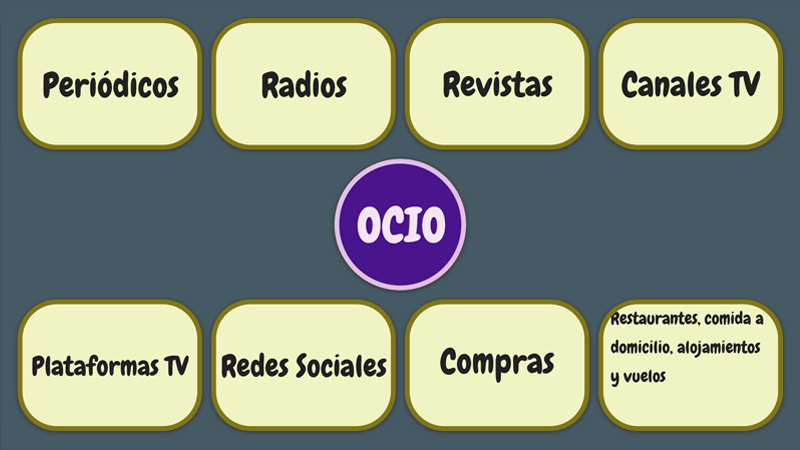
Ocio
es
Este nuevo recurso creado con Eneso Verbo presenta una serie de páginas donde encontraremos diferentes celdas que nos permitirán disfrutar de nuestro tiempo de ocio desde nuestro comunicador.
Las páginas se constituyen por categorías, como: periódicos, canales de televisión, radios, redes sociales, plataformas, hostelería y viajes, compras, entre otras.
En cada página encontraremos diferentes celdas que nos llevarán directamente a un canal on line de televisión, a un periódico concreto, a la web de una tienda, a una plataforma, a un buscador de hoteles, etc.
Puedes utilizar este recurso como tablero único para disfrutar tu ocio, puedes importar las páginas que te interesen a tu tablero de comunicación, o puedes seleccionar aquellas celdas que sean de tu interés y uso cotidiano para crear tu propio tablero de ocio.
Compartido por: Eneso

Absurdos verbales
es
Los absurdos verbales son frases en las que algunos de sus elementos son incoherentes.
Este recurso de Verbo presenta una actividad para trabajar los absurdos verbales ofreciendo diferentes niveles en los que tendremos que descubrir cuál es el absurdo verbal de cada oración, para poder escribir correctamente dicha frase.
Compartido por: Eneso

Reino animal
es
Este tablero es una digitalización y adaptación de los contenidos referentes al Reino Animal.
Compartido por: Eneso

¡Carnaval!
es
Actividad para trabajar la fiesta de Carnaval.
Compartido por: Eneso

Abecedario con pictogramas
es
La lectura es una herramienta esencial en el desarrollo de la inteligencia y una gran aliada en la puesta en marcha de nuestras funciones ejecutivas. Además, favorece el desarrollo de la creatividad y la fantasía, de la capacidad atencional, la concentración y la memoria.
Este Abecedario con Pictogramas supone un gran recurso de apoyo para el aprendizaje de la lectoescritura. Nos ayudará a asociar las letras a imágenes que empiezan por ese fonema y a practicar lo aprendido, ya que contiene varias opciones de palabras para poder deletrearlas y escribirlas.
Compartido por: Eneso

Escribe tu carta a Papá Noel o a los Reyes Magos
es
¡Escribamos una carta a Papá Noel o a Los Reyes Magos! ¡Con esta actividad será muy fácil y divertido escribir una carta navideña para pedir nuestros regalos! Elige entre diferentes tipo de papel, sobres y frases para personalizarla.
Una vez escrita podrás guardarla en PDF para imprimirla.
Compartido por: Eneso

¿Dónde está? Navidad
es
Actividad tipo memory donde debemos encontrar una imagen de temática navideña recordando dónde está localizada dentro de su grupo.
Compartido por: Eneso

Tablero inicio: Matemáticas
es
Con este recurso podrás tener, en una sola carpeta, una colección de tableros para trabajar las distintas matemáticas. Los tableros “Inicio” nos permiten conectar diferentes tipos de materiales para que el trabajo de determinadas competencias y contenidos se realice de manera más sencilla, rápida y sin tener que cerrar, buscar y abrir los distintos recursos que necesitemos. Desde nuestro tablero Inicio podremos acceder a todos los tableros correspondientes a matemáticas y, a su vez, desde estos últimos tableros, volver al inicio.
Compartido por: Eneso
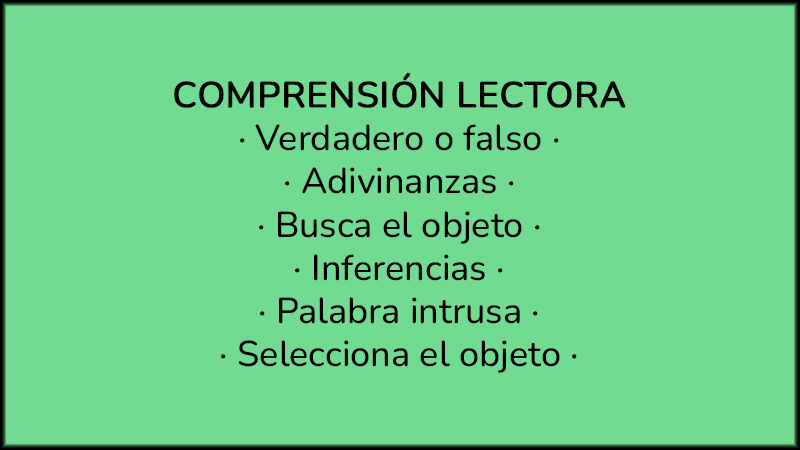
Tablero inicio: Comprensión lectora
es
Con este recurso podrás tener, en una sola carpeta, una colección de tableros para trabajar las distintas comprensión lectora]. Los tableros “Inicio” nos permiten conectar diferentes tipos de materiales para que el trabajo de determinadas competencias y contenidos se realice de manera más sencilla, rápida y sin tener que cerrar, buscar y abrir los distintos recursos que necesitemos. Desde nuestro tablero Inicio podremos acceder a todos los tableros correspondientes a comprensión lectora] y, a su vez, desde estos últimos tableros, volver al inicio.
Compartido por: Eneso

Tablero inicio: Categorías gramaticales
es
Con este recurso podrás tener, en una sola carpeta, una colección de tableros para trabajar las distintas categorías gramaticales. Los tableros “Inicio” nos permiten conectar diferentes tipos de materiales para que el trabajo de determinadas competencias y contenidos se realice de manera más sencilla, rápida y sin tener que cerrar, buscar y abrir los distintos recursos que necesitemos. Desde nuestro tablero Inicio podremos acceder a todos los tableros correspondientes a categorías gramaticales y, a su vez, desde estos últimos tableros, volver al inicio.
Compartido por: Eneso

Reglas de acentuación
es
Las reglas de acentuación determinan dónde y cuándo llevarán tilde las palabras, además de proporcionarnos información sobre aquellas palabras que, independientemente de las reglas básicas de acentuación, llevarán tilde por su propia peculiaridad y características.
Aplicar las reglas de acentuación implica implica que sepamos dividir la palabra en sílabas, que entendamos qué es una sílaba tónica y una sílaba átona y, por último, que sepamos diferenciar los tipos de palabras más básicas (llanas, agudas y esdrújulas), además de entender cuando llevarán tilde cada una de ellas.
Con este nuevo recurso aprenderemos, de manera dinámica, qué son las sílabas átonas y tónicas, cuáles son las palabras llanas, agudas y esdrújulas y cómo y cuándo acentuarlas.
Las diferentes actividades que componen esta adaptación de material curricular, nos brindan la posibilidad de guardar las respuestas que den los/as usuarios/as y así valorarlas con detenimiento o utilizar el material como examen adaptado.
Compartido por: Eneso

Prefijos y sufijos
es
Hemos creado este tablero para explicar y trabajar prefijos y sufijos, que son elementos gramaticales que cambian el significado de la palabra que acompañan.
Este nuevo recurso de material curricular se compone de una breve explicación con ejemplos y actividades para afianzar los conocimientos trabajados.
Las diferentes actividades que componen esta adaptación de material curricular nos ofrecen la posibilidad de guardar las respuestas dadas para valorarlas con detenimiento o utilizar el material como examen adaptado.
Compartido por: Eneso

Sinónimos y antónimos
es
Los sinónimos son palabras distintas pero que significan lo mismo, mientras que los antónimos son palabras que significan lo contrario. A priori son dos conceptos que parecen fáciles de entender y poner en práctica, pero que en la realidad resultan trabajosos y complicados, debido a que se trata de dos conceptos opuestos.
Con este nuevo recurso de material curricular adaptado queremos enseñar qué son y cómo pueden enriquecer nuestro lenguaje cotidiano los sinónimos y los antónimos, ya que son grandes aliados en los procesos de construcción del léxico y en los procesos de lectoescritura.
Este material se compone de una breve explicación con ejemplos y tres actividades diferentes, una de ellas que funciona a través de un enlace externo que le llevará a una página web.
Las diferentes actividades que componen esta adaptación de material curricular nos ofrecen la posibilidad de guardar las respuestas dadas para valorarlas con detenimiento o utilizar el material como examen adaptado.
Compartido por: Eneso

Sujeto y predicado
es
Aprender cómo se estructura una oración simple y ser capaces de diferencias las partes que la componen es importante para el correcto desarrollo del lenguaje, tanto verbal como no verbal. Con este nuevo tablero queremos trabajar de manera dinámica las oraciones atendiendo a esas cuestiones, comprendiendo cuál es la diferencia entre sujeto y predicado, cómo identificarlos y qué papel desarrolla cada uno.
El material cuenta con una breve pero precisa explicación y una serie de actividades para afianzar los conocimientos trabajados.
Las diferentes actividades que componen este tablero nos ofrece la posibilidad de guardas las respuestas de las y los usuarios para poder valorarlas con detenimiento y corregirlas, dando la opción de usar este material como examen adaptado.
Compartido por: Eneso

Masculino y femenino
es
El tablero Masculino y Femenino nos permite aprender y trabajar, de manera dinámica y divertida, el género de las palabras, saber distinguirlo y poder utilizarlo correctamente en una oración, un texto o una situación comunicativa.
El material cuenta con explicaciones y actividades que reforzarán el proceso de aprendizaje.
Las diferentes actividades que componen esta adaptación de material curricular, nos brindan la posibilidad de guardar las respuestas que den los/as usuarios/as y así valorarlas con detenimiento o utilizar el material como examen adaptado.
Compartido por: Eneso

Singular y plural
es
El tablero Singular y Plural nos permite aprender y trabajar, de manera dinámica y divertida, el número de las palabras, saber distinguirlo y poder utilizarlo correctamente en una oración, un texto o una situación comunicativa.
El material cuenta con explicaciones y actividades que reforzarán el proceso de aprendizaje.
Las diferentes actividades que componen esta adaptación de material curricular, nos brindan la posibilidad de guardar las respuestas que den los/as usuarios/as y así valorarlas con detenimiento o utilizar el material como examen adaptado.
Compartido por: Eneso
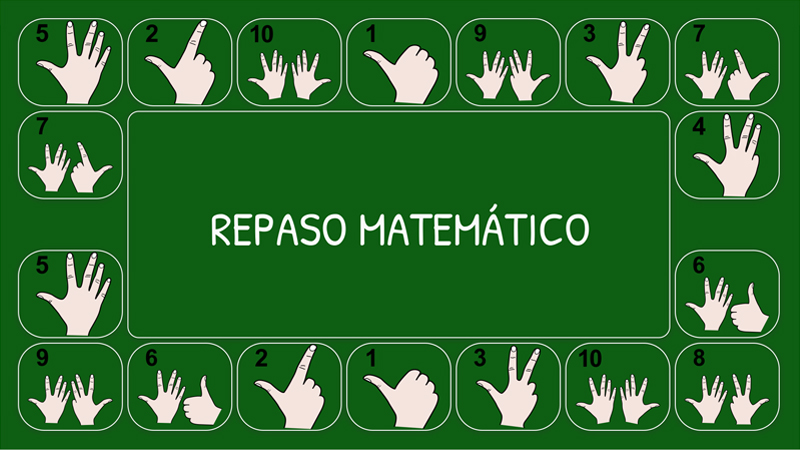
Repaso matemático
es
La finalidad de las matemáticas en educación primaria es construir los fundamentos del razonamiento lógico – matemático, ya que es imprescindible hacer que el alumnado reflexione y no limitar su educación a la memorización de conceptos.
Por ello hemos creado este tablero compilatorio de ejercicios matemáticos, pensados para repasar distintos contenidos de manera fácil, cómoda y divertida.
Este recurso reúne los siguientes contenidos: tableros matemáticos, problemas, tablas de multiplicar y actividad de repaso, números romanos y actividades, lectura y escritura de números de cuatro cifras. Todas las actividades se explican brevemente.
Las diferentes actividades que componen este tablero nos ofrecen la posibilidad de guardas las respuestas de las y los usuarios para poder valorarlas con detenimiento y corregirlas, dando la opción de usar este material como examen adaptado.
Compartido por: Eneso

Números romanos
es
Antes de que los árabes trajesen a Europa su sistema de numeración, que es el que utilizamos hoy en día, hace mucho tiempo, en la Antigua Roma, los romanos inventaron un sistema de numeración que todavía seguimos utilizando para algunas cosas. Son lo que llamamos números romanos.
Con este tablero podremos aprender qué son, para qué y cómo se usan los números romanos. Encontrarás una breve explicación con ejemplos y las reglas básicas, y tres actividades para afianzar y repasar lo aprendido.
Compartido por: Eneso

Divisiones
es
La finalidad de las matemáticas en educación primaria es construir los fundamentos del razonamiento lógico – matemático, ya que es imprescindible hacer que el alumnado reflexione y no limitar su educación a la memorización de conceptos.
Es por eso por lo que hemos creado una serie de tableros donde podemos trabajar las operaciones aritméticas básicas (sumas, restas, multiplicación y división) al mismo tiempo que potenciamos la resolución de problemas y cálculo mental.
El tablero Divisiones contiene una breve explicación con ejemplos y una serie de actividades: operaciones, con dos niveles de dificultad, y problemas.
Compartido por: Eneso

Multiplicaciones
es
Hemos creado una serie de tableros donde podemos trabajar las operaciones aritméticas básicas (sumas, restas, multiplicación y división) al mismo tiempo que potenciamos la resolución de problemas y cálculo mental.
La finalidad de las matemáticas en educación primaria es construir los fundamentos del razonamiento lógico – matemático, ya que es imprescindible hacer que el alumnado reflexione y no limitar su educación a la memorización de conceptos.
En el tablero Multiplicaciones contiene una breve explicación con ejemplos, las tablas de multiplicar del 1 al 10, una actividad para repasar las tablas, una serie de multiplicaciones divididas en dos niveles de dificultad y problemas, donde el usuario deberá reflexionar antes de hacer las operaciones.
Compartido por: Eneso

Sumas y restas
es
La finalidad de las matemáticas en educación primaria es construir los fundamentos del razonamiento lógico – matemático, ya que es imprescindible hacer que el alumnado reflexione y no limitar su educación a la memorización de conceptos.
Es por eso por lo que hemos creado una serie de tableros donde podemos trabajar las operaciones aritméticas básicas (sumas, restas, multiplicación y división) al mismo tiempo que potenciamos la resolución de problemas y cálculo mental.
En el tablero Sumas y restas contiene una breve explicación con ejemplos de ambas operaciones y una serie de actividades ordenadas en tres niveles de dificultad.
Compartido por: Eneso

Palabras compuestas
es
Las palabras compuestas son el producto del proceso morfológico conocido como composición, es decir, son aquellas palabras que se forman a partid de la unión de dos raíces o lexemas que dan lugar a una nueva unidad sintáctica y semántica.
Esta nueva unidad es independiente de las que la componen, por lo que tiene sus propias reglas de acentuación y ortografía.
Con este nuevo recurso proponemos una adaptación de material curricular con el que trabajar la compresión y el aprendizaje de las palabras compuesta y de los diferentes tipos que las componen, mediante un juego que nos brinda la posibilidad de guardar las respuestas que den los/as usuarios/as y así valorarlas con detenimiento o utilizar el material como examen adaptado.
Compartido por: Eneso

Adverbios
es
Para cerrar la serie de tableros con los que trabajar las categorizas gramaticales, os dejamos este recurso para trabajar los adverbios. Como en todas las categorías gramaticales, se trata de un tipo de palabras que presentan bastante dificultad en su proceso de aprendizaje, por lo que requieren trabajo, práctica y apoyo para su comprensión, asimilación, aprendizaje y reconocimiento. Con este material podremos trabajarlos de manera dinámica ya que cuenta con explicaciones y ejemplos de todas las características y tipos de adverbios, además de actividades que apoyan la comprensión y el aprendizaje de los mismos. Las diferentes actividades que componen esta adaptación de material curricular, nos brindan la posibilidad de guardar las respuestas que den los/as usuarios/as y así valorarlas con detenimiento o utilizar el material como examen adaptado.
Compartido por: Eneso
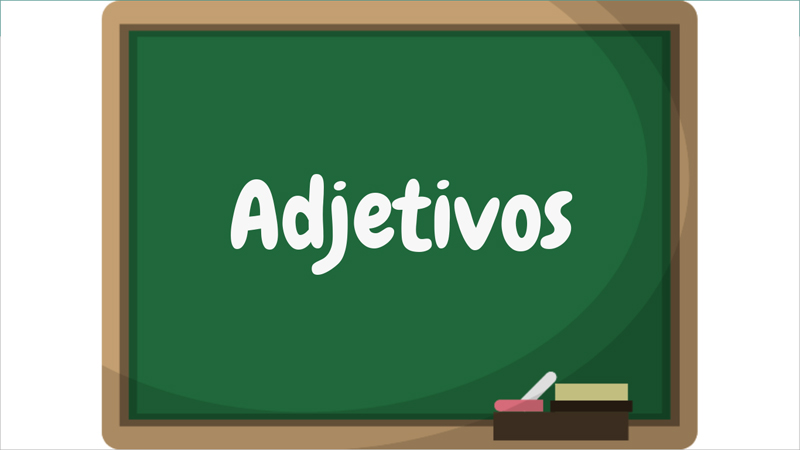
Adjetivos
es
Los adjetivos son aquellas palabras que acompañan al nombre o sustantivo, añadiendo información sobre él, como una cualidad o una característica que complementa su significado. Siempre concuerdan en género y número con los nombres o sustantivos.
Se trata de un tipo de palabra que guardan cierta complejidad debido a los diferentes usos que presenta y los diferentes grados en los que podemos usarlas.
Por ello, hemos desarrollado este recurso adaptado, con el objetivo de favorecer la compresión, la asimilación y el aprendizaje de los adjetivos, sus características, sus usos y sus grados.
Las diferentes actividades que componen esta adaptación de material curricular, nos brindan la posibilidad de guardar las respuestas que den los/as usuarios/as y así valorarlas con detenimiento o utilizar el material como examen adaptado.
Compartido por: Eneso

Verbos
es
Hemos preparado un tablero con el que trabajar los Verbos. Otro tipo de palabras que cuentan con bastante dificultad en su proceso de aprendizaje, por lo que necesitan bastante trabajo, práctica y apoyo para su comprensión, asimilación, aprendizaje y reconocimiento.
Con este material podremos trabajarlos de manera dinámica ya que cuenta con explicaciones y ejemplos de todas las características y peculiaridades de los verbos y actividades que apoyan la comprensión y el aprendizaje de los mismos.
Las diferentes actividades que componen esta adaptación de material curricular, nos brindan la posibilidad de guardar las respuestas que den los/as usuarios/as y así valorarlas con detenimiento o utilizar el material como examen adaptado.
Compartido por: Eneso

Pronombres
es
Le toca el turno a los pronombres. Otro tipo de palabras, que al igual que pasa con los determinantes y nombres o sustantivos, necesitan de trabajo, práctica y apoyo para su comprensión, asimilación, aprendizaje y reconocimiento. Con este material podremos trabajarlos de manera dinámica ya que cuenta con explicaciones y ejemplos de todos los tipos de pronombres y actividades que apoyan la comprensión y el aprendizaje de los mismos. Las diferentes actividades que componen esta adaptación de material curricular, nos brindan la posibilidad de guardar las respuestas que den los/as usuarios/as y así valorarlas con detenimiento o utilizar el material como examen adaptado.
Compartido por: Eneso

Nombres
es
Al igual que pasa con los determinantes, los nombres o sustantivos son un tipo de palabra que causa ciertos problemas en la asimilación y el aprendizaje de los mismos. Sus tipos, sus usos y el aprendizaje, la asimilación, el reconocimiento y la puesta en práctica de este tipo de palabras no es tarea fácil cuando nos enfrentamos a ellos y requieren de mucha práctica. Con este material podremos trabajarlos de manera dinámica ya que cuenta con explicaciones y ejemplos de todos los tipos de nombres o sustantivos y actividades que apoyan la comprensión y el aprendizaje de estos. Las diferentes actividades que componen esta adaptación de material curricular nos brindan la posibilidad de guardar las respuestas que den los/as usuarios/as y así valorarlas con detenimiento o utilizar el material como examen adaptado.
Compartido por: Eneso

Determinantes
es
Los determinantes son aquellas palabras que acompañan a un nombre o sustantivo, con el objetivo de concretarlo o determinarlo, aportando información sobre su género, número, situación en el espacio o posesión. Este concepto, en multitud de ocasiones, muestra problemas en la asimilación y el aprendizaje del mismo, de ahí que con este nuevo recurso propongamos una adaptación de material curricular con el que trabajar la compresión y el aprendizaje de los determinantes, sus tipos y los diferentes usos de cada uno de ellos. Las diferentes actividades que componen esta adaptación de material curricular nos brindan la posibilidad de guardar las respuestas que den los/as usuarios/as y así valorarlas con detenimiento o utilizar el material como examen adaptado.
Compartido por: Eneso

Inferencias
es
Las inferencias hacen referencia al proceso de interpretación que llevamos a cabo para deducir el significado implícito de un enunciado a partir del contexto y de los indicios que se tienen.
A través de las inferencias podemos transformar la información que recibimos en un hecho explícito, ya que, al inferir, estamos razonando para poder comprender dicha información, lo que será de gran utilidad para trabajar razonamiento lógico, comprensión verbal, comprensión lectora, asociación, organización, deducción y flexibilidad cognitiva.
Se trata de un material útil para el trabajo y la intervención con niños/as, adultos y personas mayores.
Compartido por: Eneso

Adivinanzas
es
Las adivinanzas son un recurso excepcional como material de apoyo, material didáctico para el aprendizaje y material para el trabajo en estimulación cognitiva y funciones ejecutivas, ya que favorecen el trabajo y el desarrollo del pensamiento lógico, del pensamiento deductivo, de la lógica de situaciones, del ingenio, de la imaginación y de la creatividad, mediante el planteamiento de soluciones lógicas a problemas sencillos.
Además de tratarse de un recurso didáctico fundamental en Educación Primaria, estamos ante una herramienta muy utilizada con adultos y personas mayores en estimulación cognitiva, gracias a su versatilidad, su adaptabilidad y sus diferentes niveles de dificultad y razonamiento.
Compartido por: Eneso

Busca el objeto
es
Presentamos un nuevo recurso que nos permite trabajar comprensión lectora y desarrollar estrategias que nos ayuden en el trabajo de esta competencia.
En “Busca el objeto”, tablero dividido en distintos niveles en los que encontraremos desde oraciones con un par de elementos, hasta textos pequeños, tendremos que seleccionar todas aquellas imágenes que guarden relación con lo que dicen dichas oraciones o textos, por lo que, al mismo tiempo que trabajamos comprensión lectora, fomentamos y trabajamos concentración, atención y memoria.
Compartido por: Eneso

Selecciona el objeto
es
Con este juego de pistas podremos trabajar comprensión lectora y desarrollar estrategias que nos ayuden en el trabajo de esta competencia.
La comprensión lectora o lectura comprensiva hace referencia a la capacidad para entender lo que leemos, tanto en la comprensión general y global del texto, como en la comprensión de las palabras.
Este recurso, presentado en diferentes niveles, nos propone determinadas pistas a través de las cuales deberemos de seleccionar el objeto al que hacen referencia.
Compartido por: Eneso

Verdadero o falso
es
La comprensión lectora o lectura comprensiva hace referencia a la capacidad que tenemos de comprender lo que hemos leído, no solo en el significado individual de cada una de las palabras que compongan la oración o el texto que estemos leyendo, si no del sentido y significado de esa oración o ese texto.
Hemos desarrollado diferentes tableros, con los que poder trabajar comprensión lectora y desarrollar estrategias que nos ayuden en el trabajo de esta competencia.
Este es un juego de Verdadero/Falso, en el que nos encontraremos diferentes textos, de menor a mayor dificultad divididos en niveles, en el que tendremos que responder a ciertas preguntas o afirmaciones seleccionando V/F.
Compartido por: Eneso

Agendas y rutinas
es
Con este tablero podrás organizar tu día, tu semana, y rutinas de 3, 6 y 8 pasos, aprendiendo a controlar el tiempo y a priorizar, entender y realizar cada una de las tareas incluidas en tu rutina.
Este recurso es especialmente útil para niños, que podrán completar las rutinas con sus padres o tutores, ayudándoles a sentirse seguros y con el control de su tiempo y obligaciones.
También es interesante para personas más mayores o de la tercera edad, que podrán trabajar la organización de sus actividades y tareas de una manera útil y llamativa.
Compartido por: Eneso

Agudeza visual
es
Las actividades y juegos basados en el desarrollo de la percepción o la discriminación visual son esencial para trabajar aspectos como la concentración, la agudeza visual, la atención y la asociación. Son perfectamente válidas tanto para niños/as como para adultos/as, ya que nos ayudarán a estimular el desarrollo cognitivo y a prevenir cualquier dificultad que pueda surgir en este sentido.
A través de la percepción visual interpretamos y/o discriminamos todos aquellos estímulos externos visuales que se encuentran en nuestro entorno y que los hemos aprendido previamente, mientras que la agudeza visual es la capacidad que tiene nuestro sistema visual para poder distinguir los detalles de esos estímulos de manera clara y nítida.
Compartido por: Eneso
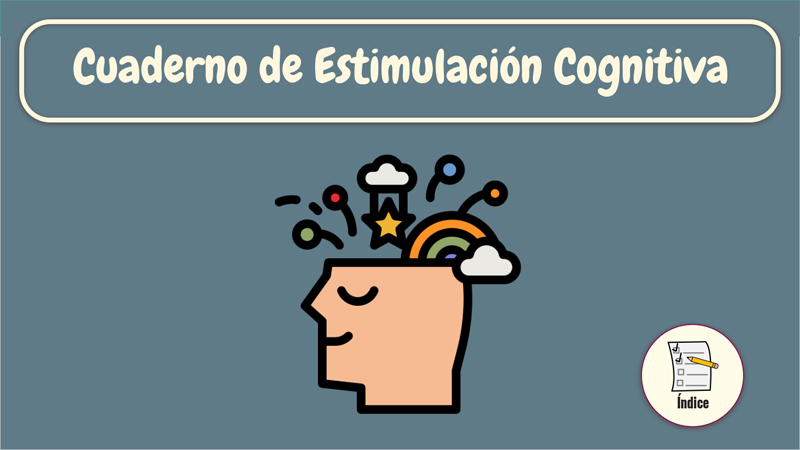
Cuaderno de estimulación cognitiva 2
es
Cuando hablamos de estimulación cognitiva, hacemos referencia a una serie de actividades, juegos y/o técnicas que nos ayudan a mejorar el funcionamiento de las capacidades cognitivas, tales como la orientación, la atención, la memoria, el lenguaje y las funciones ejecutivas, al mismo tiempo que trabajamos aspectos como las habilidades visoespaciales, las praxias o las gnosias.
Este nuevo Cuaderno de Estimulación Cognitiva cuenta con 14 tipos de actividades diferentes para poder trabajar con niños/as, adultos/as y personas mayores.
Compartido por: Eneso

Cuaderno de repaso para verano
es
En verano es momento de disfrutar y pasarlo bien, pero también debemos repasar todo lo aprendido durante el curso escolar.
¿Que mejor que realizar ese repaso de manera divertida?
En este nuevo recurso encontraremos diferentes actividades y juegos para trabajar durante el verano a la misma vez que nuestros/as niños/as se divierten y siguen aprendiendo.
El cuaderno está adaptado para un nivel de 2º – 3º de Educación Primaria.
Compartido por: Eneso

Abecedario con imágenes
es
El tablero “Abecedario con Imágenes” complementa la actividad subida con anterioridad, “Vocales con Imágenes”.
Como explicábamos en el anterior, se trata de un recurso mediante el cual trabajaremos las letras del abecedario asociando su sonido al de diferentes objetos que comienzan por cada una de las letras, lo que ayudará en la comprensión de que cada palabra se compone de diferentes sonidos y que cada fonema (letra) tiene su propio sonido.
Compartido por: Eneso

Sudoku
es
El Sudoku es un pasatiempo de lógica, cuyo objetivo es rellenar las casillas ayudándonos de las imágenes, números o letras que ya estén colocados, sin repetir ninguno de ellos en la misma fila o columna.
Hemos adaptado el sudoku para hacerlo accesible desde Verbo y contar con esta actividad entre las muchas que forman la biblioteca de la Comunidad Verbo, ya que se trata de un gran recurso para trabajar lógica, razonamiento, atención, memoria y concentración.
Trabajar los sudokus con los/as niños/as, desde edades tempranas, y con personas mayores en intervención y estimulación cognitiva, conlleva numerosos beneficios para todos/as ellos/as, ya que implicar pensar a través de secuencias, desarrollar la comprensión espacial, el reconocimiento de patrones y la toma de decisiones al elegir el elemento que debemos de colocar en cada casilla.
Compartido por: Eneso

Identificar sílabas con Among Us
es
Durante el aprendizaje de la lectura es necesario que se pongan en marcha estrategias de reflexión sobre la composición de las palabras y los texto, es lo que denominamos conciencia fonológica. Como sabemos, esta se compone de diferentes niveles, entre ellos, la conciencia silábica, que hace referencia al reconocimiento de las sílabas que componen una palabra.
Con la ayuda de este recurso, podremos trabajar la conciencia silábica mediante la identificación de las sílabas que forman las diferentes palabras que se presentan. El recurso cuenta con diversas palabras bisílabas, trisílabas y polisílabas organizadas en niveles para que podamos decidir qué palabras trabajar.
Compartido por: Eneso

Vocales con imágenes
es
El tablero “Vocales con Imágenes” es un recurso mediante el cual trabajaremos las vocales asociando su sonido al de diferentes objetos que comienzan por cada vocal, lo que ayudará en la comprensión de que cada palabra se compone de diferentes sonidos y que cada fonema (letra) tiene su propio sonido.
Se trata de un juego mediante el cual podremos iniciar el proceso de aprendizaje de la lectura.
Compartido por: Eneso
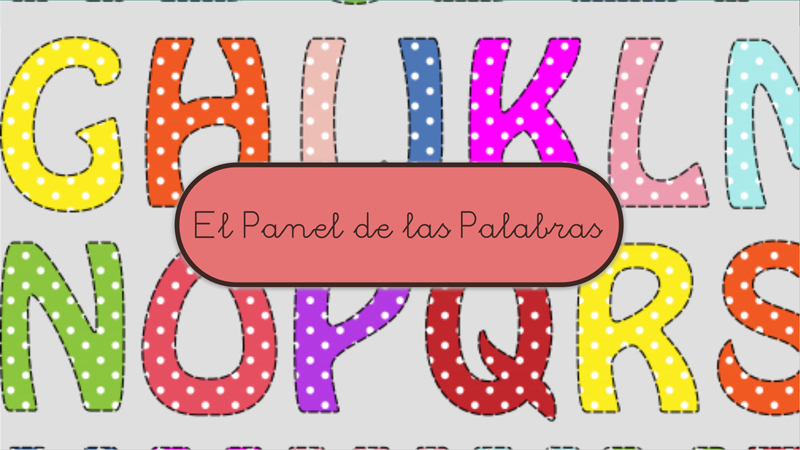
El panel de las palabras
es
El Panel de las Palabras es una adaptación del juego “Pasapalabra”.
Con este tablero, directamente relacionado con la competencia lingüística, podremos trabajar vocabulario, familia de palabras, campos semánticos, categorías gramaticales, reglas ortográficas, definiciones y/o cualquier tipo de vocabulario o área.
El juego, tal y como está para descargarlo, cuenta con una serie de preguntas, por letra del abecedario, en las que tendremos que decir de qué palabra se trata. Pero podemos adaptarlo para trabajar las diferentes áreas y competencias que estimemos oportuno, con solo modificar las preguntas.
No solo se trata de un recurso versátil para trabajar las competencias educativas, sino que es perfectamente adaptable para poder utilizarlo en intervención con personas adultas, en estimulación cognitiva y en el trabajo y desarrollo de las funciones ejecutivas.
Compartido por: Eneso
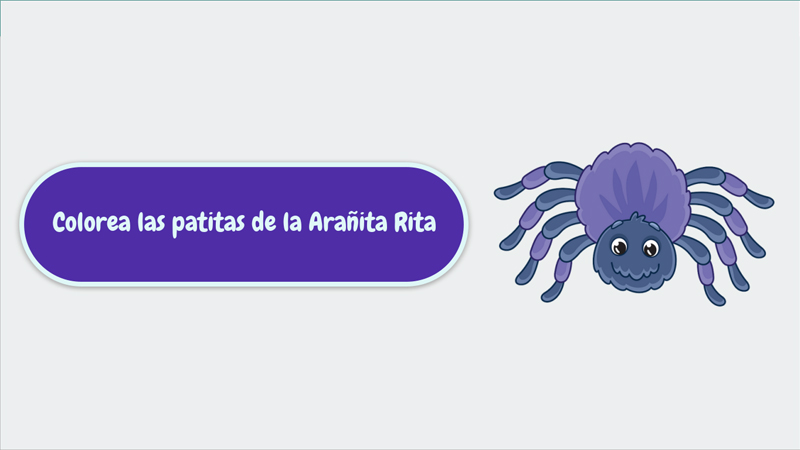
Colorea las patitas de la arañita Rita
es
Tablero en el que trabajaremos, mediante un juego, la discriminación visual y el reconocimiento de los colores.
La discriminación visual es la capacidad a través de la cual los/as niños/as pueden distinguir las diferentes propiedades de los objetos que están a su alrededor, ayudándoles a diferenciarlos y clasificarlos por color, forma, posición, tamaño, etc.
Es muy importante trabajar y formentar esta capacidad o habilidad, ya que es precursora del desarrollo del pensamiento lógico y matemático.
Con la Arañita Rita, trabajaremos la discriminación visual mediante el reconocimiento y selección de los colores que ella nos pida, al mismo tiempo que trabajamos instrucciones básicas, atención, concentración y memoria.
Compartido por: Eneso

Seriaciones
es
Tablero que cuenta con diferentes series planteadas para trabajar clasificación y organización de objetos.
Las series son un recurso esencial en el trabajo con los/as niños/as como ejercicio para trabajar y desarrollar el razonamiento lógico, la atención, la memoria, la concentración y las relaciones de orden.
Como proceso mental, las series son necesarias para aprender a comparar elementos, relacionarlos y ordenarlos en base a unas características comunes y/o un orden o patrón lógico.
Compartido por: Eneso

Hospital
es
Inspirándonos en el famoso juego “Operación”, compartimos estos dos juegos en los que podremos jugar a las operaciones al mismo tiempo que trabajamos el aprendizaje de las partes del cuerpo y de los huesos del cuerpo humano.
EL archivo contiene dos juegos:
Uno, en el que jugaremos a operar diferentes partes del cuerpo y está dirigidos a niños/as más pequeños/as.
Otro, en el que tendremos que reconocer diferentes huesos del cuerpo y que está dirigido a niños/as más mayores, proporcionando un recurso de gran utilidad como actividad de apoyo para el aprendizaje de los contenidos de Ciencias Naturales referentes al cuerpo humano.
Compartido por: Eneso

Concurso de palabras
es
El “Concurso de Palabras” es una adaptación del juego “Deletrea”. Con este recurso, útil para usarlo como juego o como actividad evaluativa y/o de diagnóstico, trabajaremos la formación de las palabras.
La formación de palabras es un elemento esencial en los procesos de aprendizaje de la lectoescritura y de desarrollo de la conciencia fonológica. Entender que una palabra se divide en unidades más pequeñas, que unidas entre sí forman un todo con sentido y significado, abre el camino para el aprendizaje de procesos posteriores de suma importancia para el desarrollo y el aprendizaje de los/as niños/as.
Además de brindarnos la posibilidad de utilizarlo como recurso de apoyo en procesos de evaluación del lenguaje y del aprendizaje de la lectura.
No solo se trata de una actividad para trabajar con niños/as, también podemos utilizarla en el trabajo de la estimulación cognitiva con personas mayores.
Compartido por: Eneso

Qué personaje es
es
Tablero basado en el juego “¿Quién es quién?”. A través de este recurso, podremos jugar, de manera interactiva y guiada, a este conocido juego.
La mecánica del juego cambiará un poco, ya que el/a profesional debe colocar, de manera visible y accesible para el/a usuario/a el panel con todos los personajes que tiene el juego. De esta manera, el/a usuario podrá ir realizando las preguntas que quiera, a través de su tablero, hasta llegar al personaje previamente elegido por el/a profesional.
En el propio recurso encontraréis las instrucciones.
Gracias a la posibilidad que nos brinda Verbo de imprimir las páginas, contextos o niveles de los tableros, podremos tener, de manera física y accesible, la página con los personajes.
Compartido por: Eneso

Vamos a comer
es
Tablero que combina un pequeño cuento y un juego para trabajar las distintas rutinas a la hora de comer.
Para muchos/as niños/as con Trastorno del Espectro Autista (TEA) y sus familias, la hora de la comida es un momento difícil y temido, ya que, estos/as niños/as pueden presentar disfunciones o dificultades alimentarias, tales como, comportamientos disruptivos, rechazo a determinados alimentos, problemas de trastornos alimenticios.
Es importante que se introduzcan rutinas que ayuden a comprender los cambios y comportamientos que debemos aprender y realizar en este sentido. Trabajar estos hábitos a través de cuentos, juegos y pictogramas, siempre será de ayuda.
Como consejo o sugerencia, podemos imprimir en PDF la página en la que aparecen los pictogramas con las rutinas para la hora de la comida y así tenerla siempre visible y accesible.
Compartido por: Eneso

Tangram
es
Actividad basada en el juego del “Tangram”. A través de este recurso, en el que hemos adaptado y creado una versión interactiva del Tangram, podremos crear diferentes figuras al mismo tiempo que trabajamos reconocimiento de colores y de formas geométricas planas.
Compartido por: Eneso
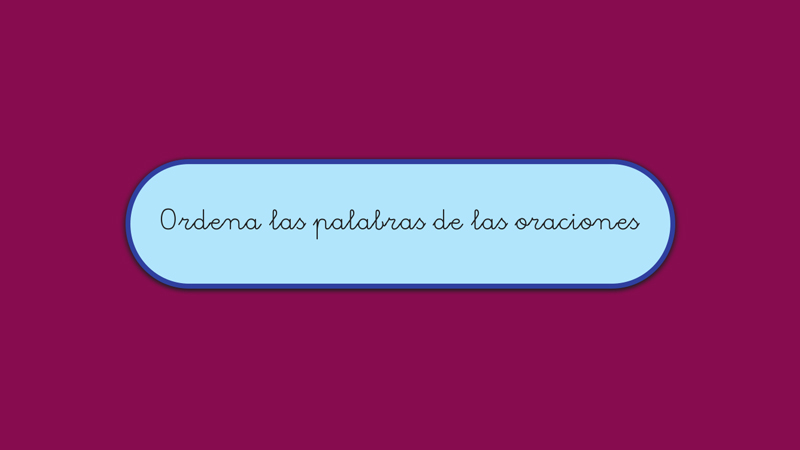
Crear oraciones
es
La conciencia fonológica es la capacidad para reconocer, reflexionar, utilizar y manipular, de manera consciente, los sonidos y segmentos de los que se compone el lenguaje.
Podemos trabajarla desde todos sus niveles, conciencia léxica, conciencia silábica, conciencia fonémica y/o conciencia semántica.
A través de la colección de tableros que podréis descargar desde el archivo zip que se adjunta, podremos trabajar la conciencia léxica y semántica. El archivo contiene cinco tableros con ejercicios para ordenar las partes de las oraciones:
Tres de ellos, divididos en diferentes niveles, que guardarán las respuestas en la propia actividad además de generar un pdf con los resultados. Estos tableros se basan en una representación del lenguaje mixta, es decir, utilizando texto y pictogramas para cada palabra.
Dos de ellos, basados en una representación del lenguaje textual y divididos por niveles, los cuales también guardarán las respuestas de los/as usuarios/as además de generar un pdf con los resultados.
Compartido por: Eneso

Conciencia Silábica. Palabras Trisílabas
es
Tablero para trabajar la conciencia fonológica mediante la conciencia silábica y la división, en sílabas, de palabras trisílabas. Este tablero puede utilizarse como juego, como actividad de clase y como actividad evaluable, ya que guarda las respuestas de los usuarios, tanto en el propio tablero como en un archivo PDF.
Compartido por: Eneso

Estimulación cognitiva y funciones ejecutivas
es
Actividad para trabajar funciones ejecutivas, estimulación cognitiva, memoria, atención y concentración con niños/as y con personas mayores, mediante la discriminación de diferentes elementos. Permite adaptar cada nivel o página a las características de todos los usuarios.
Este recurso, gracias a la posibilidad de convertir los tableros en PDF e imprimirlos con la que cuenta Verbo, podemos adaptarlo a aquellas personas que no están familiarizadas con los dispositivos electrónicos.
Compartido por: Eneso

Conciencia Silábica. Palabras Bisílabas
es
Tablero para trabajar la conciencia fonológica a través de la conciencia silábica y la división, en sílabas, de palabras bisílabas.
Este tablero puede utilizarse como juego, como actividad de clase y como actividad evaluable, ya que guarda las respuestas de los usuarios, tanto en el propio tablero como en un archivo PDF.
Compartido por: Eneso

Bingo de vocabulario
es
Actividad para trabajar diferentes familias de palabras a través del juego del bingo.
Compartido por: Eneso

Entrenamiento táctil Nivel 3
es
Tablero diseñado para trabajar, mediante estímulos, el entrenamiento táctil. Juego que nos permite trabajar el reconocimiento y la discriminación entre dos animales, el sonido que emiten, además de la anticipación de alguna actividad programada con animales.
Compartido por: Eneso

Entrenamiento táctil Nivel 2
es
Tablero diseñado para trabajar, mediante estímulos, el entrenamiento táctil. Juego que nos permite trabajar el sonido de los animales, además de la anticipación de alguna actividad programada con animales.
Compartido por: Eneso

Entrenamiento táctil Nivel 1
es
Tablero diseñado para trabajar, mediante estímulos, el entrenamiento táctil. Juego que nos permite trabajar el sonido de los animales, además de la anticipación de alguna actividad programada con animales.
Compartido por: Eneso

Entrenamiento táctil Colores
es
Tablero diseñado para trabajar, mediante estímulos, el entrenamiento táctil y el reconocimiento de colores.
Compartido por: Eneso

Alfabeto Dactilológico
es
Tablero para aprender el alfabeto dactilológico con símbolos de https://www.fundacioncnse.org/educa/bancolse/dactilologico.php con licencia Creative Commons Attribution-NonCommercial-ShareAlike sobre los que se han realizado algunos cambios.
Compartido por: Eneso

Ejemplo de conjugación (portugués)
pt
(En
portugués)
Tablero que muestra, en forma de tutorial, la capacidad de conjugación automática de Verbo en persona, número y tiempo verbal, incluyendo formas reflexivas y afectivas.
Compartido por: Eneso

Ejemplo de conjugación (italiano)
it
(En
italiano)
Tablero que muestra, en forma de tutorial, la capacidad de conjugación automática de Verbo en persona, número y tiempo verbal, incluyendo formas reflexivas y afectivas.
Compartido por: Eneso

Animales vertebrados
es
Actividad para trabajar el reino de los animales vertebrados. Nivel Inicial.
Compartido por: Eneso

Comunicador núcleo Verbo 1.0
es
Un comunicador completo basado en el paradigma de vocabulario núcleo, con capacidad de conjugación automática, separación en categorías gramaticales y varias secciones semánticas.
Compartido por: Eneso

Comunicador pictos Verbo 1.0
es
Un comunicador de nivel intermedio con representación del lenguaje textual y pictográfica, usando la librería de pictogramas SymbolStix.
Compartido por: Eneso
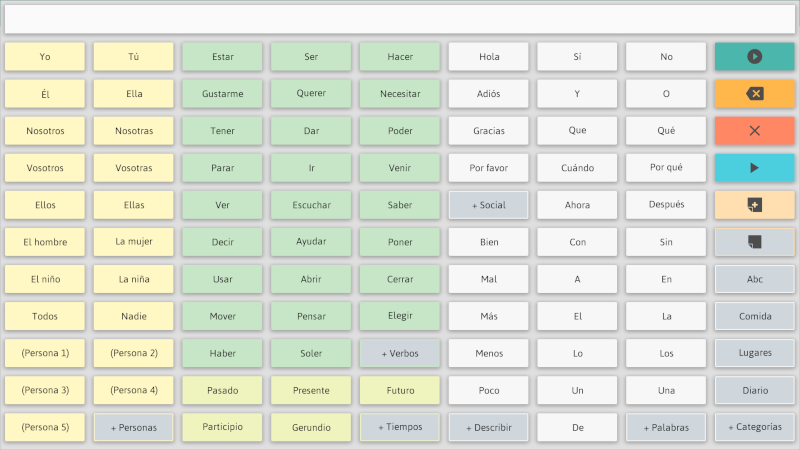
Comunicador texto Verbo 1.0
es
Un comunicador con representación del lenguaje puramente textual, con capacidad de conjugación automática en persona, número y tiempo verbal, predicción de escritura y notas. Incluye varias categorías semánticas.
Compartido por: Eneso

Comunicador fotos Verbo 1.0
es
Un comunicador basado en fotografías reales. Esta plantilla sencilla puede utilizarse como base para crear tableros personalizados a partir de fotografías del usuario.
Compartido por: Eneso

Teclado claro Verbo 1.0
es
Un teclado virtual con predicción de escritura y capacidad para almacenar notas. Estilo claro.
Compartido por: Eneso

Teclado oscuro Verbo 1.0
es
Un teclado virtual con predicción de escritura y capacidad para almacenar notas. Estilo oscuro.
Compartido por: Eneso

Exemple de conjugació (Català)
ca
(En
catalán)
Tauler que mostra, en forma de tutorial, la capacitat de conjugació automàtica de Verbo en persona, nombre i temps verbal, incloent formes reflexives i afectives.
Compartido por: Eneso

Ejemplo de conjugación (Español)
es
Tablero que muestra, en forma de tutorial, la capacidad de conjugación automática de Verbo en persona, número y tiempo verbal, incluyendo formas reflexivas y afectivas.
Compartido por: Eneso

Escenas de Halloween
es
¿Conoces el nombre de los elementos que forman parte de cada escena?
Compartido por: Eneso

Vocabulario de Halloween
es
Actividad para introducir nuevos pictogramas en el vocabulario. Diseñada con distintas páginas y vocabulario relacionado con la festividad de Halloween.
Compartido por: Eneso

Discriminación visual Halloween
es
Actividad ambientada en la fiesta de Halloween para trabajar la disciminación visual y el conteo. Consiste en encontrar el objeto indicado dentro de un conjunto de otros objetos similares.
Compartido por: Eneso

Selecciona el que es igual
es
Se trata de una actividad para trabajar la memoria y la atención. Consiste en seleccionar el pictograma que se repite dentro de la misma fila. Posee un refuerzo positivo auditivo y la celda correcta se desvanece automáticamente al pulsarla.
El tablero está formado por 25 niveles y cada uno de ellos está asociado a una letra concreta del alfabeto.
Compartido por: Eneso

Aprende a utilizar el dinero
es
Se trata de una actividad educativa que consiste en seleccionar las monedas y billetes que se necesitan para alcanzar una cantidad exacta. Las celdas con la respuesta correcta se desvanecen al pulsarlas y dan un refuerzo positivo auditivo al usuario. Las respuestas del usuario, se guardarán automáticamente en un documento .pdf.
Compartido por: Eneso
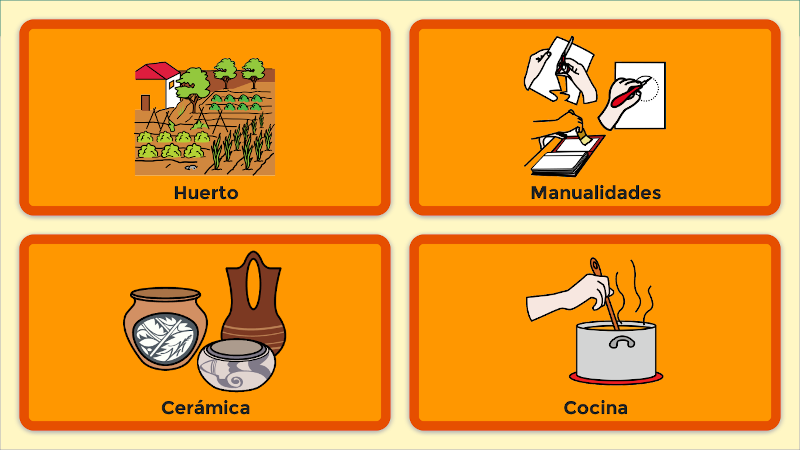
Talleres, tablero de anticipación
es
En este tablero encontraréis la anticipación a cuatro talleres. En este caso: huerto, manualidades, cocina y cerámica. Dentro de cada taller, están enumeradas las principales actividades que se suelen realizar en ellos. Por ejemplo, si pincháis en la celda que pone huerto, os llevará a una página donde aparecen enumeradas una serie de acciones como sembrar, regar, recolectar, arrancar, abonar y podar.
Compartido por: Eneso

Taller de manualidades, marco de fotos
es
Es un tablero de anticipación. En este caso, hemos puesto como ejemplo la creación de un marco de fotos personalizado. El tablero incluye los pasos a seguir y una galería con el material que se puede utilizar para llevar a cabo la manualidad, además de una página con un teclado para personas que tengan adquirida la lectoescritura.
Compartido por: Eneso
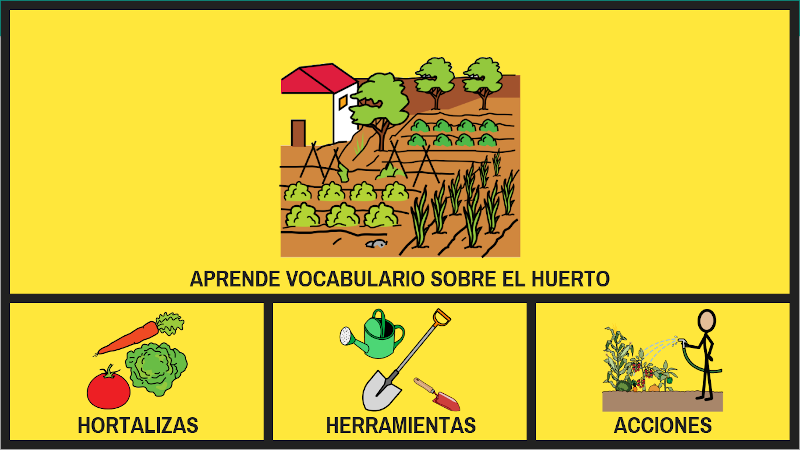
Taller de huerto, actividad de asociación
es
Se trata de una actividad interactiva para trabajar la lectura global. Las palabras están divididas en tres categorías: alimentos, herramientas y acciones. Consiste en identificar la palabra que se corresponde con cada pictograma, escogiendo entre dos opciones posibles.
Compartido por: Eneso

Taller de cocina, recetario
es
Se trata de un tablero de anticipación que incluye seis recetas clasificadas en seis categorías diferentes. Cada receta abarca dos páginas, una con los ingredientes necesarios y otra con los pasos a seguir. Podéis añadir nuevas recetas y categorías para ampliar el recetario.
Compartido por: Eneso

Taller de cerámica, macetas
es
Se trata de un tablero de anticipación para la creación, en este caso, de macetas de cerámica. Incluye una página con la presentación del objeto y la lista de materiales que se necesitan. A continuación, se explican los pasos a seguir para crear la maceta.
Compartido por: Eneso

Encuentra las letras
es
Se trata de una actividad para trabajar la percepción visual, consiste en encontrar una letra concreta entre otras muchas que son similares a la que hay que buscar. Hay cuatro niveles de dificultad, al superar cada nivel la actividad nos ofrece repetir el nivel o pasar el siguiente.
Compartido por: Eneso

Taller de manualidades, materiales que puedo encontrar
es
Tablero sencillo para aprender el vocabulario de los diferentes materiales que podemos encontrar en el taller de manualidades, además, incluye una actividad de asociación donde hay que relacionar uno de esos materiales con la acción que corresponda.
Compartido por: Eneso

Piensa cómo termina el refrán
es
Consiste en averiguar cómo termina cada uno de los refranes que se plantean. Es una actividad que se puede realizar de manera individual o en grupo. Deben buscar en su memoria la terminación de cada refrán y contar el significado que creen que tiene. Podéis quitar y añadir cuántos refranes queráis.
Compartido por: Eneso

Orientación personal y temporal para personas mayores
es
El tablero está compuesto por diferentes páginas donde se invita al usuario a recordar su nombre, el lugar donde nació, el nombre de sus padres, el de sus hermanos y, entre muchas otras, la profesión a la que dedicó. Al final del tablero hay una actividad de orientación espacial para ubicar a la persona en la estación del año actual y para distinguir las prendas de ropa que se pondrían en función de la estación del año en la que estén.
Compartido por: Eneso

Identifica a la persona que aparece en la imagen
es
Consiste en identificar el nombre de varios cantantes, actores y actrices nacidos a lo largo del siglo XX en España. Al final de la actividad, podéis escuchar una canción de cada uno de los cantantes que aparecen. Pretende evocar en los usuarios experiencias pasadas.
Compartido por: Eneso

Las provincias de Andalucía
es
Se trata de una actividad de identificación donde el usuario tiene que elegir entre dos opciones la respuesta correcta, tiene una melodía de fondo y cuando acierta, pasa a la siguiente provincia tras recibir un refuerzo positivo.
Compartido por: Eneso

Discriminación entre objetos antiguos y objetos modernos
es
El tablero tiene como objetivo discriminar objetos antiguos de objetos modernos. Se presentan una serie de imágenes con objetos de diferentes épocas, la persona o personas que realicen la actividad deberán pulsar sobre “antiguo” o “moderno” según crean.
Compartido por: Eneso

¿En qué sílaba termina la palabra?
es
Es un tablero que contiene veinte pictogramas que representan palabras de dos sílabas. La actividad consiste en averiguar cuál es la sílaba en la que termina la palabra que representa cada uno de esos pictogramas. Las respuestas se van guardando a medida que se avanza en la actividad. Al final del tablero, hay una página con las respuestas dadas por el usuario y las respuestas correctas, existe la opción de guardar dichas respuestas en un archivo PDF.
Compartido por: Eneso

Cuento 'Yo me quedo en casa'
es
Se trata de un cuento para entender mejor qué es el COVID-19 o coronavirus. La protagonista es una niña que utiliza un sistema alternativo de comunicación tanto para entender el mundo como expresar sus pensamientos. Ella nos cuenta cómo está viviendo lo que está pasando desde que se decretó el estado de alarma.
Compartido por: Eneso

El juego del coronavirus
es
Se trata de un tablero que explica el juego que se ha hecho viral para adoptar una de las medidas de prevención básicas contra el COVID-19 o coronavirus. En el tablero explicamos con imágenes y pictogramas en qué consiste y cómo hay que lavarse bien las manos para hacer desaparecer el dibujo del virus.
Compartido por: Eneso

¿Qué es el coronavirus?
es
Es un tablero creado para hacer accesible la información más importante sobre el COVID-19, conocido también como coronavirus. El tablero explica con pictogramas y texto qué es, cuáles son los síntomas más frecuentes, qué medidas debemos adoptar para combatirlo y una lista de ideas para hacer en casa los días que dure el estado de alarma declarado por el Gobierno.
Compartido por: Eneso

Carnaval - Ejercicio de conteo
es
Actividad ambientada en la fiesta de carnaval para trabajar el conteo. Consiste en contar los disfraces que aparecen en cada página del tablero.
Compartido por: Eneso

Carnaval - Actividad
es
Tablero ambientado en la fiesta de carnaval que consiste en asociar un complemento al disfraz que le corresponda.
Compartido por: Eneso

Carnaval - Explicación y canción
es
Tablero ambientado en la fiesta de carnaval que favorece la comprensión de qué es y cómo se celebra.
Compartido por: Eneso
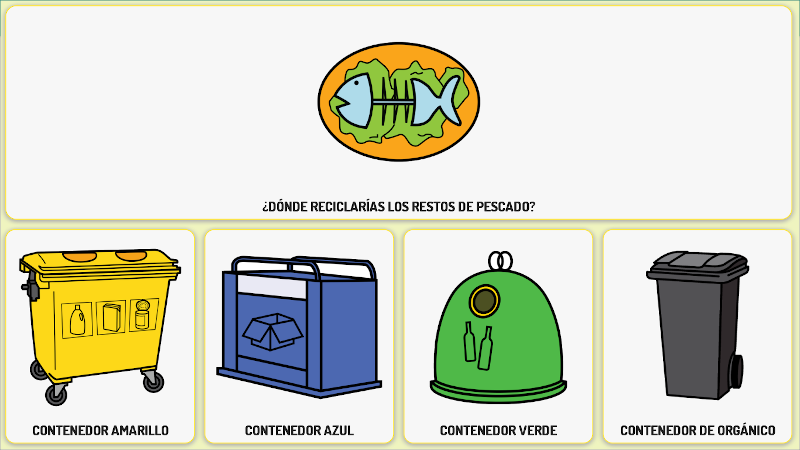
Aprende a reciclar, actividad y valoración de los resultados
es
Activad de evaluación que consiste en clasificar una serie de residuos en los distintos contendedores que existen. Los resultados se guardarán automáticamente en un archivo pdf.
Compartido por: Eneso
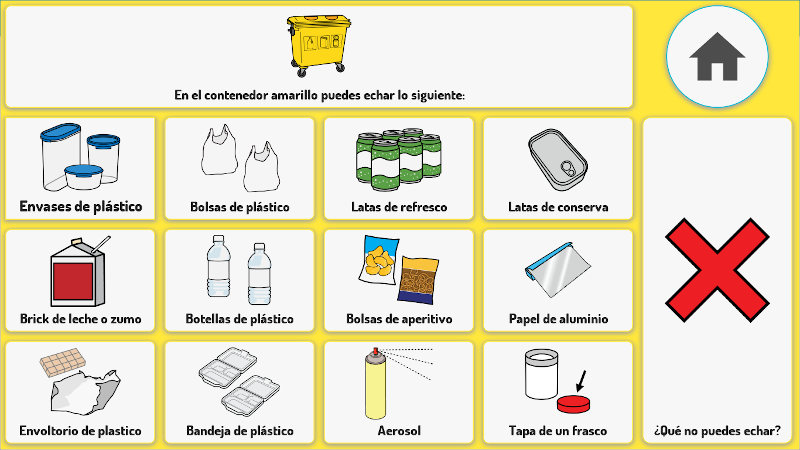
Aprende a reciclar, teoría y práctica
es
Tablero donde se exponen los contenedores que existen, qué contienen y qué no se puede reciclar en ellos. Incluye una actividad para poner en práctica lo aprendido.
Compartido por: Eneso

Aprende a reciclar, mapa conceptual y canción
es
Tablero sencillo donde se presentan los distintos contenedores que existen, de qué color son y qué contiene cada uno. De fondo, y a lo largo de todo el tablero, suena una melodía. Al final, en la última página, hay un enlace a un vídeo musical.
Compartido por: Eneso

Aprende a reciclar, esto va en...
es
Tablero de anticipación de una sola página que contiene los pictogramas de cuatro contenedores distintos. Lo podemos utilizar como herramienta a la hora de ir a reciclar.
Compartido por: Eneso

Comunicador conjugado
es
Tablero de comunicación con posibilidad de conjugar los 120 verbos más utilizados en nuestro idioma. Incluye frases hechas para charlas rápidas, preguntas, respuestas opiniones y más de 20 categorías de vocabulario para hablar de prácticamente todo, además de acceso a teclado predictivo, música y videos. Combina el estilo SAAC con una gama de colores más variada, pictogramas y texto.
Compartido por: Eneso

Rimas - Resultados
es
¿Puedes encontrar la palabra que rima? Esta versión muestra al final una página con las respuestas esperadas y las del usuario.
Compartido por: Eneso

Orden alfabético de letras - Resultados
es
Ordena los grupos de tres letras por orden alfabético. Al final se muestra una página con los resultados esperados y las respuestas del usuario.
Compartido por: Eneso

Encuentra el intruso - Resultados
es
Actividad educativa en la que se debe indicar el elemento que no pertenece a la categoría común entre otras tres imágenes. Esta versión muestra al final una página con las respuestas del usuario y las esperadas.
Compartido por: Eneso

Comparar animales
es
Actividad para seleccionar el animal correcto según la pregunta formulada. Utiliza pictogramas grandes, sonidos reales y letra enlazada de tipo escolar. Esta versión muestra al final una página de resultados con las respuestas del usuario y las esperadas.
Compartido por: Eneso

Categorías - Resultados
es
Descubre a qué categoría semántica corresponde la imagen que aparece. Al final se muestra una página con las respuesta del usuario y los resultados correctos.
Compartido por: Eneso

Pseudopalabras - Resultados parciales
es
Intenta descubrir qué palabras son inventadas y cuáles son reales. Esta versión guarda las respuestas del usuario en capa página como archivos pdf.
Compartido por: Eneso

Voy a la compra - Notas
es
Tablero de comunicación para ir a la compra. Contiene diferentes categorías de productos, de medidas y de manejo de dinero. Recomendamos que lo modifiques, añadiendo los productos que compres más habitualmente. Esta versión incluye notas para guardar mensajes y recuperarlos después.
Compartido por: Eneso

SAAC - Notas
es
Ejemplo de tablero usando el esquema de colores del sistema SAAC. Combina pictogramas SymbolStix y texto. Incluye páginas de familia, amigos, colores, ropa, lugares y actividades. Esta versión incluye notas para guardar los mensajes y recuperarlos después.
Compartido por: Eneso
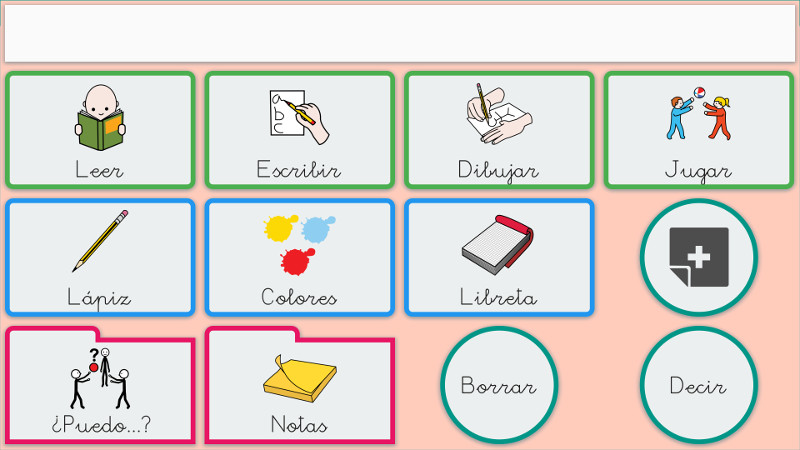
En el colegio - Notas
es
Tablero de comunicación en el entorno escolar que utiliza pictogramas y texto de letra enlazada en un estilo SAAC Bordes. Incluye página sobre acciones habituales y nombres de compañeros. Esta versión añade notas para poder guardar mensajes y decirlos más tarde.
Compartido por: Eneso

Alto contraste con notas
es
Letras gruesas y una combinación de colores de alto contraste para personas con baja agudeza visual. Permite guardar mensajes como notas y recuperarlos después.
Compartido por: Eneso

Recuerda las fotografías
es
Fíjate en las fotografías y recuerda los detalles para responder correctamente.
Compartido por: Eneso

Memoria visual
es
Juego de memoria visual. ¿Cuál es la imagen que ha cambiado?
Compartido por: Eneso

Busca el modelo
es
Selecciona el que es igual al modelo.
Compartido por: Eneso

Selecciona las imágenes iguales
es
Pulsa sobre las imágenes que son iguales.
Compartido por: Eneso

El juego de las bombillas
es
Actividad para trabajar en la atención visual y la rapidez de selección. Ideal para comenzar el entrenamiento con pulsadores o sistemas de seguimiento visual.
Compartido por: Eneso

Juego de memoria auditiva
es
Actividad para utilizar con barrido auditivo. Pon a prueba tu memoria auditiva y responde a las preguntas.
Compartido por: Eneso

Completa la frase
fr
(En
francés)
¿Qué palabra falta para completar la frase? Usa las pictogramas para ayudarte.
Compartido por: Eneso

¿Qué sucedió antes?
es
Ordena las imágenes según el orden lógico de aparición en cada historia.
Compartido por: Eneso

Señales de tráfico
es
Identifica las señales de tráfico y conoce su significado.
Compartido por: Eneso

Medios de transporte
es
Tablero en italiano para responder distintas cuestiones sobre los medios de transporte.
Compartido por: Eneso

El ratón glotón
es
Pequeña historia de un ratoncito en problemas. Lee o escucha el cuento y realiza las actividades relacionadas.
Compartido por: Eneso

Las mariquitas
es
¿Cuántas mariquitas hay? Muchas, pocas, una o ninguna.
Compartido por: Eneso

Adjetivos calificativos
es
Elige el mejor adjetivos calificativo para las palabras dadas.
Compartido por: Eneso

Cantidades
es
Observa las imágenes y responde a la pregunta sobre cantidades.
Compartido por: Eneso

Categorías de palabras
es
Aprende sobre las categorías de las palabras. La mejor forma de mejorar el uso de tu comunicador.
Compartido por: Eneso

Elige la vocal que se repite
es
Observa y escucha las imágenes y elige la vocal correspondiente.
Compartido por: Eneso

Saac celdas grandes con fotografías
es
Tablero de comunicación básica con fotografías para la iniciación en la comunicación aumentativa. Muy útil para personas que no utilizan pictogramas ni lectoescritura. Podrás reemplazar las imagenes por tus propias fotografías para conseguir un comunicador más realista y significativo.
Compartido por: Eneso

Alto contraste categorías y teclado
es
Teclado alfabético y silábico que incluye varias páginas de categorías con una combinación de colores de alto contraste.
Compartido por: Eneso

Málaga
es
Un paseo por las zonas más conocidas de la provincia malagueña. Conoce los monumentos, calles, museos y zonas características de Málaga a través de este tablero adaptado con pictogramas y texto.
Compartido por: Eneso

Mi comunicador para el colegio
es
Tablero de comunicación en el entorno escolar que utiliza pictogramas y texto de letra enlazada en un estilo SAAC Bordes. Incluye página sobre las acciones que puedo hacer,mis compañeros de clase, mi agenda escolar y mis materiales. Además contiene un teclado predictivo sencillo para potenciar la lectoescritura.
Compartido por: Eneso

Hablo sobre mi familia
es
¿Quién es quien? Actividad para manejar los términos y relaciones de parentesco. Cambia los pictogramas por tus propias fotografías y habla sobre los miembros de tu familia.
Compartido por: Eneso

Elige la fotografía correcta
es
Sencilla actividad de reconocimiento de imágenes con fotografías reales para personas que comienzan la abstracción simbólica al uso de pictogramas. Indica la fotografía correcta entre tres opciones. Ideal para iniciar el entrenamiento con pulsadores o seguimiento visual.
Compartido por: Eneso
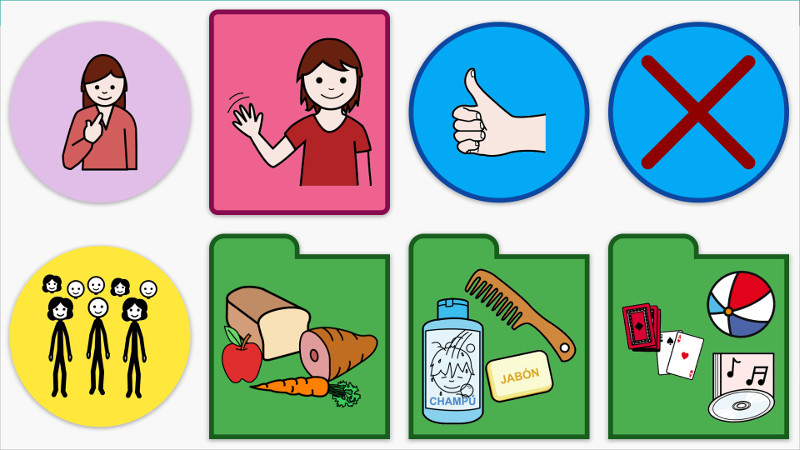
SAAC Celdas grandes
es
Tablero de comunicación inicial, sencillo, visual y con las celdas grandes. Utiliza pictogramas sin texto en colores del estilo SAAC.
Compartido por: Eneso
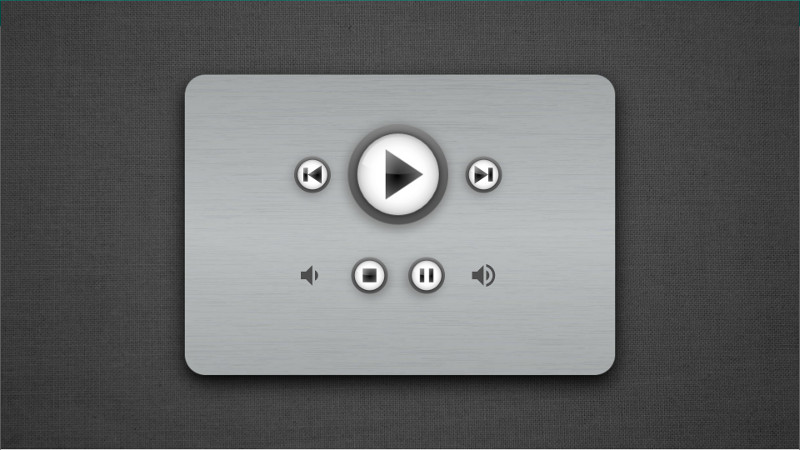
Reproductor de música con aspecto metálico
es
Un reproductor de aspecto metálico para reproducir la música de tu ordenador.
Compartido por: Eneso

Alto contraste con control de mirada
es
Teclado de letras gruesas y una combinación de colores de alto contraste para personas que utilizan un sistema de acceso por la mirada.Incluye botones de pausa y calibración del seguimiento visual en la pantalla.
Compartido por: Eneso

Juego de sumas simple
es
Actividad de sumas sencillas con números enteros. Atiende al cálculo propuesto en cada nivel la manzana con la respuesta correcta.
Compartido por: Eneso

Juego Halloween
es
Descubre las más terroríficas escenas y supera las pantallas salvando al niño asustado de todos los monstruos. Sube el volumen y destapa las casillas adecuadas. ¿Te atreves a jugar?
Compartido por: Eneso

Trastorno específico del lenguaje
es
Para conmemorar el Día internacional sobre la Concienciación del Trastorno Específico del Lenguaje (TEL), hoy 30 de Septiembre lanzamos este nuevo tablero con cuatro actividades diseñadas para cada dimensión lingüística: Fonológica - Identifica el fonema /ñ/ o /ll/.Semántica - Describe el objeto. Morfosintáctica - Ordena las palabras para formar una frase.Pragmática - Crea tu propio cuento y grábalo con tu voz.¡Crea más niveles y personaliza la actividad!
Compartido por: Eneso

Rutina lavarse las manos
es
¡Conoce la historia de Pedro y aprende la rutina del lavado de manos! Cuento interactivo para niños y niñas con dificultad en las funciones ejecutivas.
Compartido por: Eneso

Aprender símbolos Bliss (Inglés)
en
(En
inglés)
Este juego facilita el aprendizaje de nuevos símbolos Bliss en el vocabulario. Escucha la palabra que se indica para buscar su fotografía real y su símbolo. Adaptado para su uso con voz en inglés.
Compartido por: Eneso

Recuerda el símbolo Bliss (Inglés)
en
(En
inglés)
Intenta encontrar el símbolo Bliss que has visto hace unos segundos entre todos los demás. Adaptado para su uso con voz en inglés.
Compartido por: Eneso

Intruso fácil Bliss (Inglés)
en
(En
inglés)
Actividad educativa en la que se debe indicar el símbolo Bliss que no pertenece a la categoría común entre otros tres conceptos. Adaptado para su uso con voz en inglés.
Compartido por: Eneso

Comparar animales Bliss (Inglés)
en
(En
inglés)
Versión del tablero Comparar animales utilizando símbolos Bliss. Adaptado para su uso con voz en inglés.
Compartido por: Eneso

Tablero de comunicación Bliss (Inglés)
en
(En
inglés)
Tablero de comunicación usando el sistema de símbolos Bliss. Adaptado para su uso con voz en inglés.
Compartido por: Eneso

Aprendo las emociones
es
Actividad para trabajar las emociones desde el reconocimiento visual de fotografías reales. Se incluyen cuatro emociones: alegría, miedo, tristeza e ira, que pueden ampliarse.
Compartido por: Eneso

Reconocer los verbos
es
Actividad de iniciación al análisis sintáctico. Lee la frase y localiza la acción que se lleva a cabo en cada una de ellas.
Compartido por: Eneso

Teclado ABC, 123 - Sarakanda
es
Tablero de comunicación con fuente Sarakanda, tipografía diseñada para personas con dislexia. Página principal con fecha/hora, expresiones habituales y acceso a teclado predictivo ABC y numérico.
Compartido por: Eneso

Semana Santa
es
Tablero de anticipación del periodo de Semana Santa con el vocabulario y los acontecimientos típicos de esta fecha en España.
Compartido por: Eneso

Mis sentidos
es
Aprendemos más sobre nuestros cinco sentidos de forma visual y con ejemplos de actividades cotidianas. En este tablero se utilizan pictogramas de Arasaac y Symbolstix en combinación con texto.
Compartido por: Eneso

Ocio infantil
es
Tablero diseñado para ofrecer distintas actividades multimedia a los más pequeños organizado en tres páginas (mis vídeos, mis canciones y mis fotos) con enlaces para lanzar aplicaciones, que se personalizan para cada usuario.
Compartido por: Eneso

Teclado ABC predictivo
es
La página principal de este tablero incluye expresiones habituales en texto y un reloj integrado, además de enlaces a un teclado abc predictivo y a un teclado numérico. El teclado predictivo tiene una organización ABC con ocho celdas de predicción y acceso al teclado numérico.
Compartido por: Eneso

Teclado predictivo
(En
Este tablero de comunicación incluye una página principal con expresiones habituales combinadas con pictogramas de Arasaac y un reloj integrado. Se enlaza a un teclado alfabético qwerty con cinco celdas de predicción y un diseño atractivo.
Compartido por: Eneso

Toca la estrella
es
Actividad de búsqueda e identificación visual para familiarizarse con el acceso a la pantalla y valorar el sistema idóneo de acceso al ordenador o Tablet. Consta de 50 pantallas de complejidad creciente.
Compartido por: Eneso
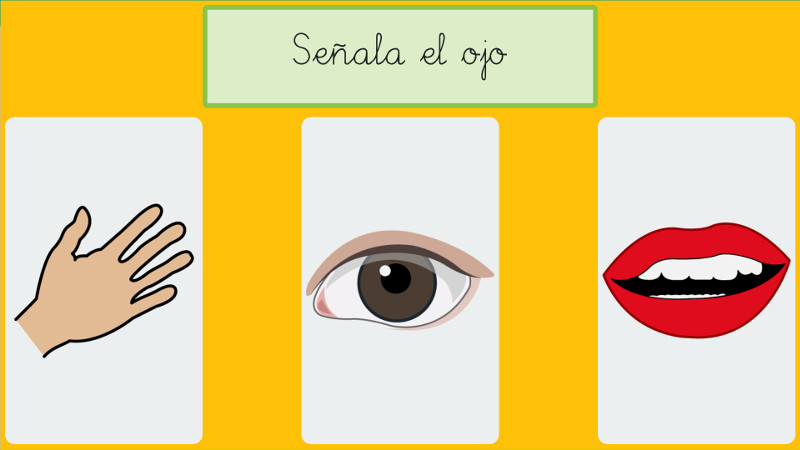
Las partes del cuerpo
es
Localiza la imagen de la parte del cuerpo indicada entre tres opciones. Ideal para continuar el entrenamiento con pulsadores o seguimiento visual.
Compartido por: Eneso

Elige la imagen correcta
es
Sencilla actividad de reconocimiento de imágenes. Escucha atentamente la consigna e indica la imagen correcta entre dos opciones. Ideal para iniciar el entrenamiento con pulsadores o seguimiento visual.
Compartido por: Eneso

Cumpleaños
es
Tablero de anticipación para niños/as con dificultades en la planificación.
Compartido por: Eneso

Juego de asociación Navidad
es
Asocia las imágenes navideñas que tengan una característica en común.
Compartido por: Eneso

Tabla de mensajes silábica
es
Tablero de comunicación a través de lectoescritura. Consta de un teclado alfanumérico y algunas palabras de uso frecuente visualmente contrastadas para facilitar su uso. Cada letra sugiere sílabas combinadas para conseguir una comunicación más fluida.
Compartido por: Eneso

Decora tu árbol
es
Sigue las instrucciones para colocar los adornos navideños y decorar fácilmente tu árbol de Navidad.
Compartido por: Eneso

Aprender pictogramas
es
Con este juego será más fácil introducir nuevos pictogramas en el vocabulario. Escucha la palabra que se indica para buscar su fotografía real y su pictograma correspondiente.
Compartido por: Eneso

Tabla de mensajes
es
Tablero de comunicación a través de lectoescritura. Consta de una sola página que incluye teclado alfanumérico, sílabas y palabras de uso frecuente, visualmente contrastadas para facilitar su uso.
Compartido por: Eneso

Calendario de adviento
es
¿Con ganas de que llegue la Navidad? ¡Con este calendario de adviento la espera será más corta! Realiza las distintas actividades propuestas para cada día y diviértete con la cuenta atrás para las fiestas.
Compartido por: Eneso
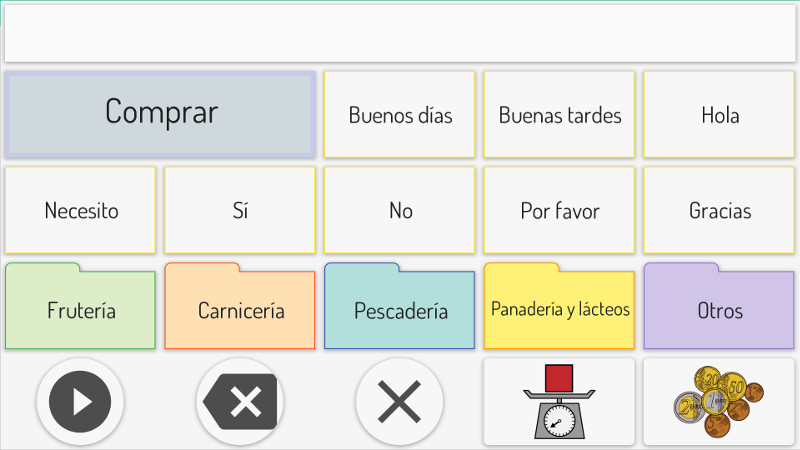
Voy a la compra
es
Tablero de comunicación para ir a la compra. Contiene diferentes categorías de productos, de medidas y de manejo de dinero. Recomendamos que lo modifiques, añadiendo los productos que compres más habitualmente.
Compartido por: Eneso

Planificación de buenas noches
es
Ejemplo de tablero de secuenciación de tareas para niños y niñas con dificultades de planificación. Las celdas proporcionan información visual sobre lo que ya se ha hecho y lo siguiente que debe hacerse.
Compartido por: Eneso

Leemos sílabas
es
Escribe las sílabas que forman la palabra indicada para pasar al siguiente nivel.
Compartido por: Eneso
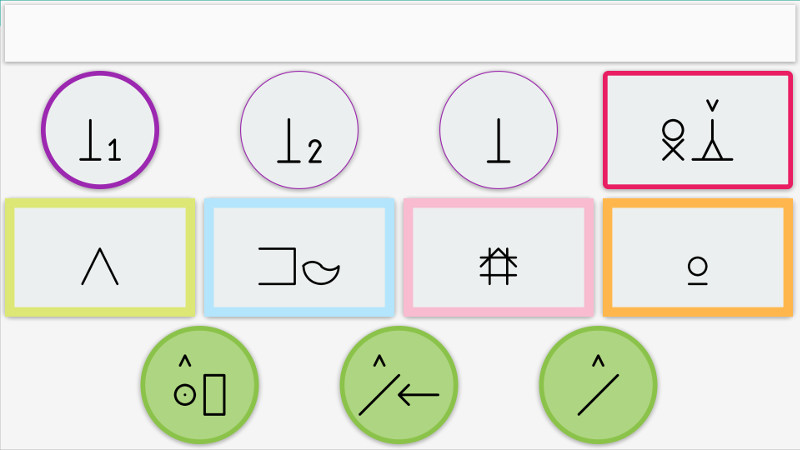
Tablero de comunicación Bliss
es
Tablero de ejemplo usando el sistema de comunicación Bliss.
Compartido por: Eneso

Reproductor de música
es
Un reproductor que puedes usar para escuchar la música de tu ordenador.
Compartido por: Eneso

Los instrumentos musicales
es
Descubre el sonido que produce cada instrumento musical y juega a intentar reconocerlos.
Compartido por: Eneso

Siluetas - Medios de transporte
es
¿Puedes identificar el medio de transporte al que se refiere la pregunta a partir de su silueta?
Compartido por: Eneso

Cómo me siento - adultos
es
Tablero de comunicación con pictogramas y palabras. Incluye categorías de sentimientos, enfermedades, partes del cuerpo, problemas y personas del entorno social.
Compartido por: Eneso

Números mayores y menores
es
Juega a comparar números.
Compartido por: Eneso

Cómo me siento
es
Un tablero con estilo SAAC sin texto para hablar de sensaciones y sentimientos a través de pictogramas.
Compartido por: Eneso

Elijo mi menú
es
¿Qué te apetece comer? Indícalo con este tablero lleno de frutas, verduras, legumbres y carnes. Combina el estilo Verbo con colores, pictogramas y texto.
Compartido por: Eneso

El búho cansado
es
Al búho le encanta trabajar de noche cantando las horas del reloj, ¡pero por el día está muy cansado! Descubre con el búho qué animales se esconden en el bosque, y demuestra lo que has aprendido con las actividades incluidas al final.
Compartido por: Eneso

Comparar animales (con sonido)
es
Versión del tablero Comparar animales con sonidos reales de animales.
Compartido por: Eneso

Sesión de trabajo
es
Plantilla de una sesión de intervención terapéutica que utiliza el estilo SAAC sin texto. Incluye un panel de planificación de actividades y una página de expresión de necesidades.
Compartido por: Eneso

Identificación de pseudopalabras
es
Intenta descubrir qué palabras son inventadas y cuáles son reales.
Compartido por: Eneso

Palabra intrusa
es
Identifica la palabra que sobra dentro de la frase.
Compartido por: Eneso

Rimas
es
¿Puedes encontrar la palabra que rima?
Compartido por: Eneso

Quiero - No quiero
es
Tablero de comunicación de actividades de la vida diaria con más de 40 categorías para hablar de tus gustos y necesidades. Combina el estilo Verbo con colores, pictogramas y texto.
Compartido por: Eneso

Orientación temporal
es
¿Qué día es hoy? ¿Qué hora es? ¿Qué tiempo hace?
Compartido por: Eneso

Los animales
es
Animales domésticos, salvajes y de granja. Dónde viven y sus características.
Compartido por: Eneso
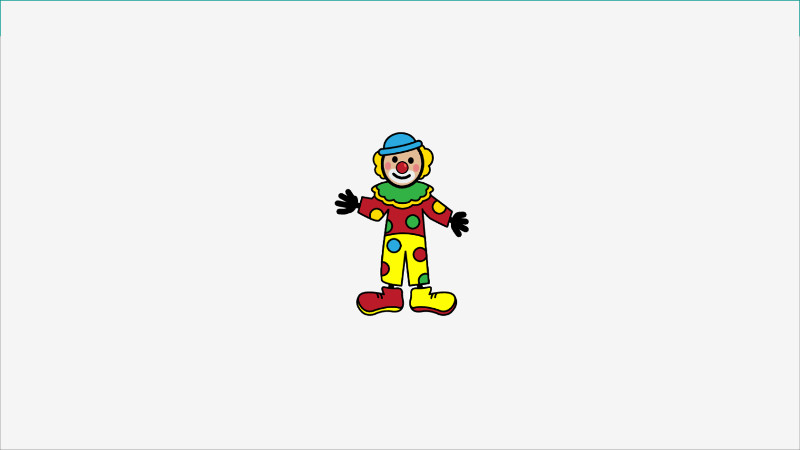
Recuerda la imagen
es
Intenta encontrar la imagen que has visto hace unos segundos entre todas las demás.
Compartido por: Eneso
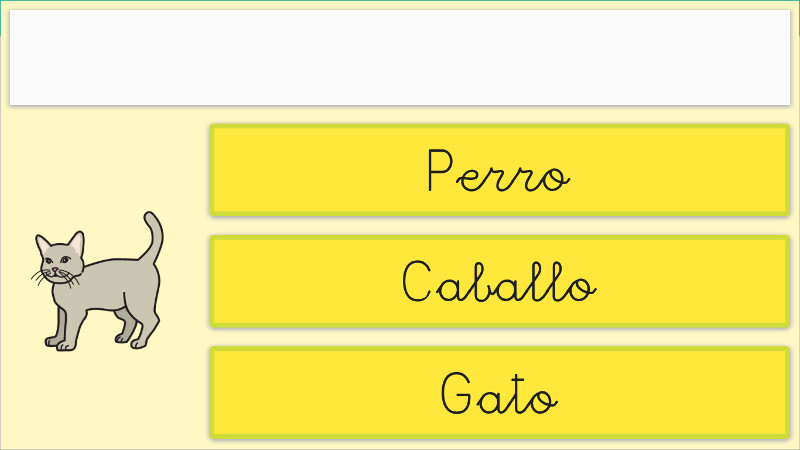
Nombre con imagen
es
Actividad para asociar la imagen que aparece con su nombre.
Compartido por: Eneso

Completa la frase
es
¿Qué palabra falta para completar la frase? Usa las pictogramas para ayudarte.
Compartido por: Eneso

Comparar animales (ARASAAC)
es
Versión del tablero Comparar animales con pictogramas de ARASAAC.
Compartido por: Eneso

¿Qué quieres comer?
es
Tablero de comunicación de alimentos sencillo con imágenes grandes y colores por categorías. Incluye categorías de fruta, verdura, carne y pescado.
Compartido por: Eneso

Teclado infantil
es
Un teclado que combina letra enlazada de tipo escolar e imágenes.
Compartido por: Eneso

Teclado
es
Además del acceso a un teclado alfabético neutro con aspecto de máquina de escribir, la página principal incluye formulaciones sociales habituales, combinando texto y pictogramas SymbolStix.
Compartido por: Eneso

Quién soy yo
es
Un tablero sencillo con pocas celdas e imágenes grandes para que puedas contar algunas cosas sobre ti.
Compartido por: Eneso

Sólo texto
es
Ejemplo de tablero sin pictogramas y un aspecto minimalista. Incluye una página de ropa y teclado sobrio.
Compartido por: Eneso

Alto contraste
es
Letras gruesas y una combinación de colores de alto contraste para personas con baja agudeza visual.
Compartido por: Eneso
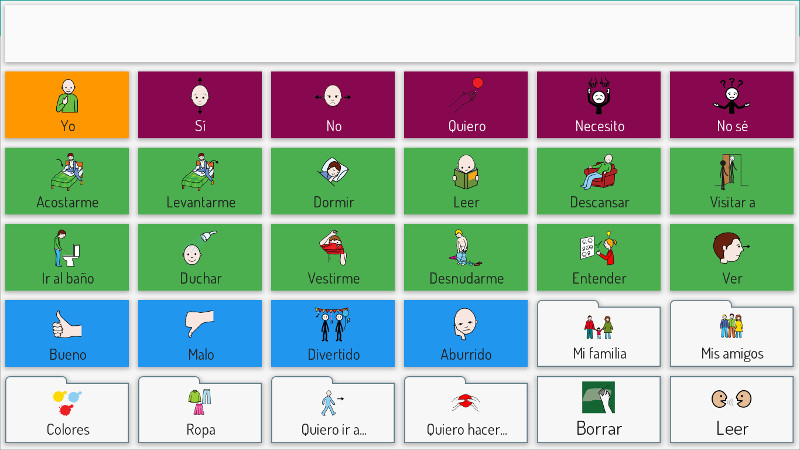
SAAC (ARASAAC)
es
Ejemplo de tablero usando el esquema de colores del sistema SAAC y los pictogramas de ARASAAC.
Compartido por: Eneso

SAAC bordes
es
Un tablero que usa los colores del sistema SAAC de forma más sutil, dejando el fondo blanco. Incluye páginas de familia, amigos, colores, ropa, lugares y actividades.
Compartido por: Eneso

Comparar animales
es
Intenta descubrir el animal al que se refiere la pregunta. Esta actividad combina pictogramas con letra caligráfica.
Compartido por: Eneso

Encuentra el intruso (difícil)
es
Actividad educativa en la que se debe indicar el elemento que no pertenece a la categoría común entre otras once imágenes.
Compartido por: Eneso

Encuentra el intruso (fácil)
es
Actividad educativa en la que se debe indicar el elemento que no pertenece a la categoría común entre otras tres imágenes.
Compartido por: Eneso

En el colegio
es
Tablero de comunicación en el entorno escolar que utiliza pictogramas y texto de letra enlazada en un estilo SAAC Bordes. Incluye página sobre acciones habituales y nombres de compañeros.
Compartido por: Eneso

Mi primer tablero
es
Tablero muy sencillo que combina imágenes y palabras con estilo SPC. Es el tablero de ejemplo creado en el manual de usuario del programa. Incluye formas sociales, familia y verbos básicos en la página de inicio, además de una segunda página de comida.
Compartido por: Eneso



























































































































































































































